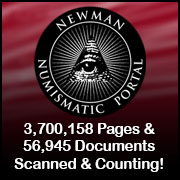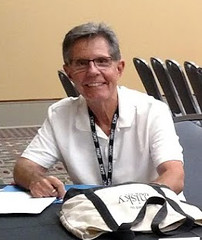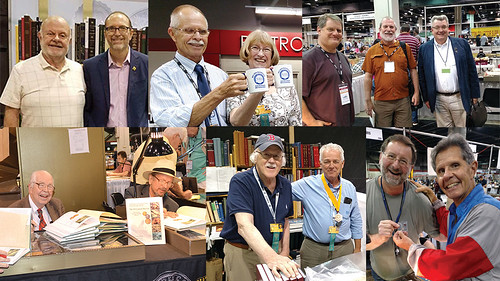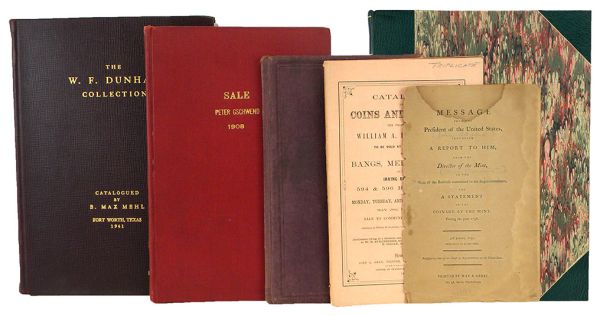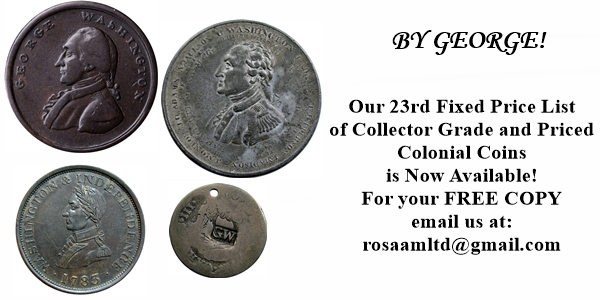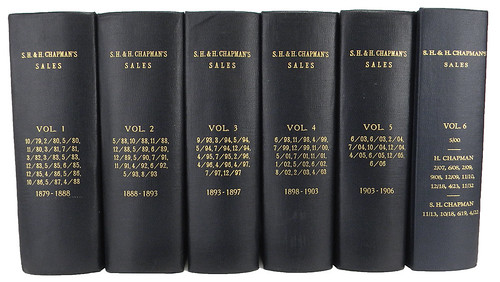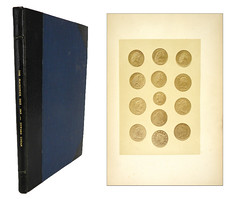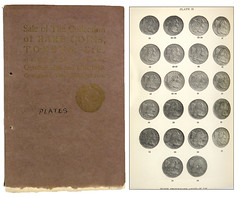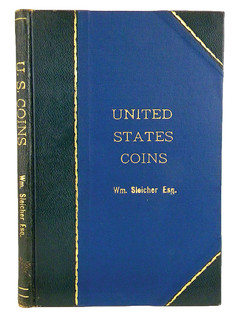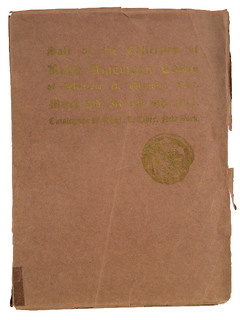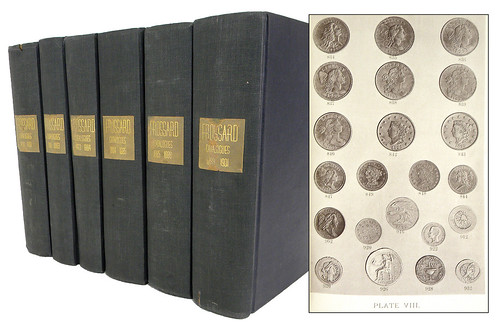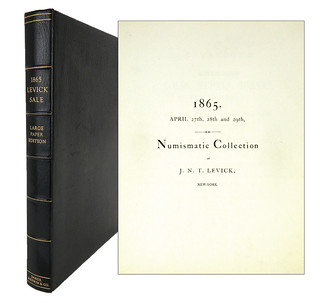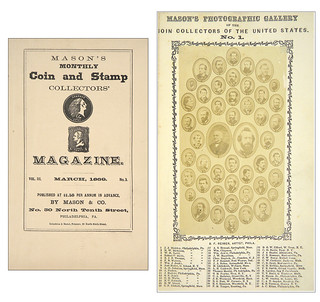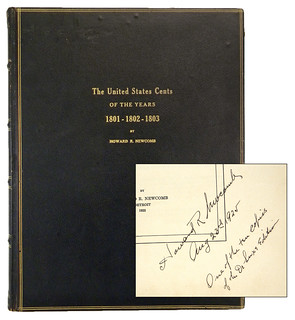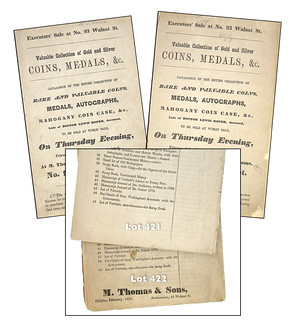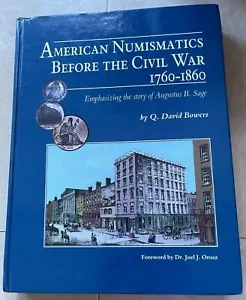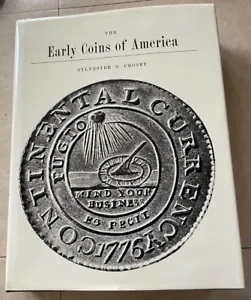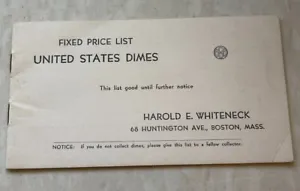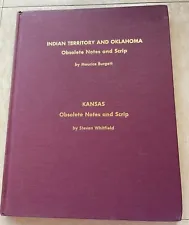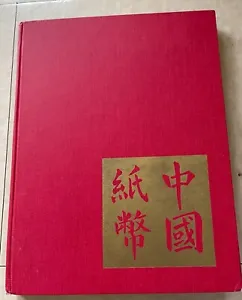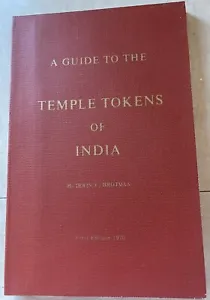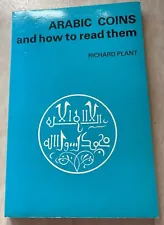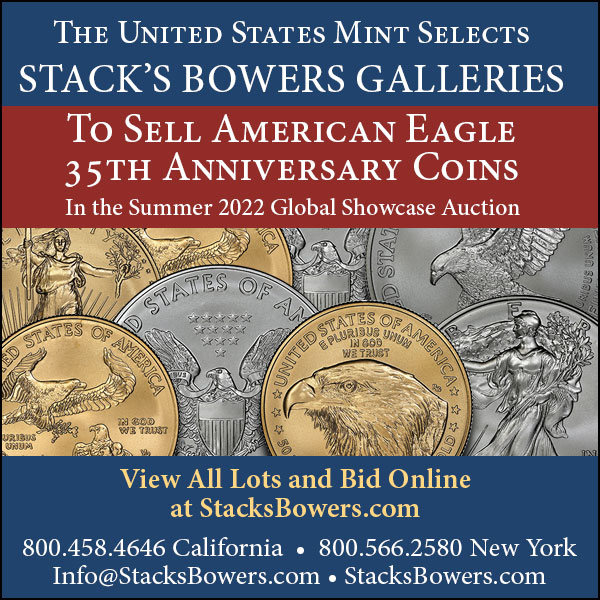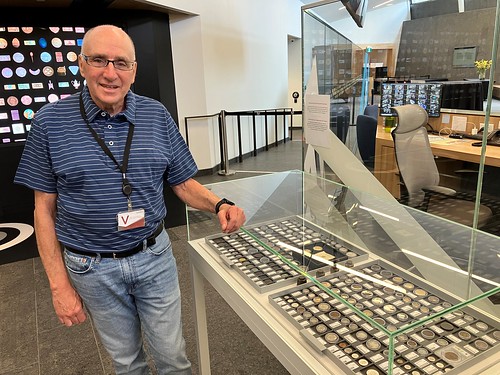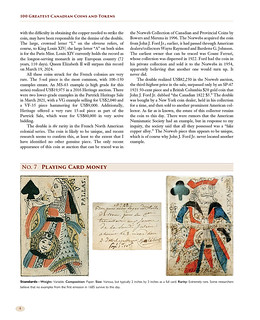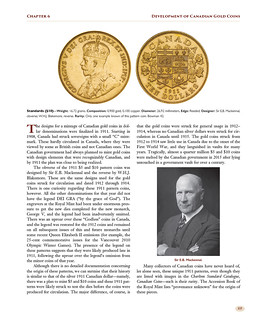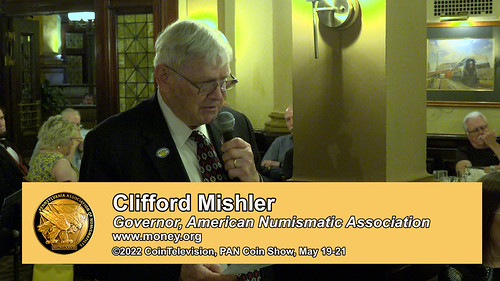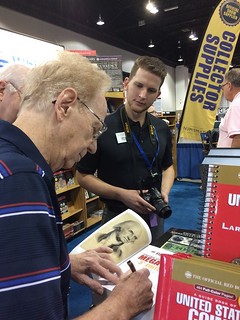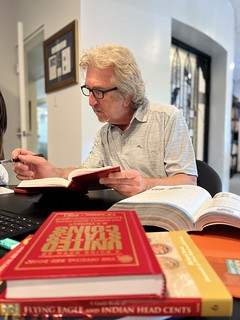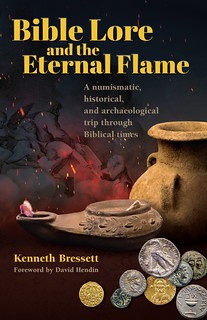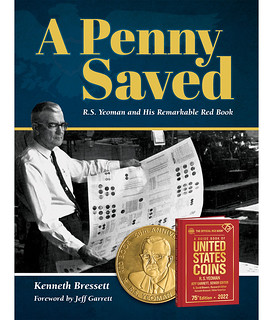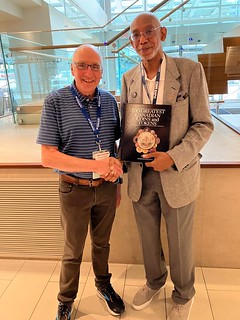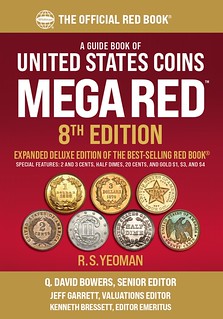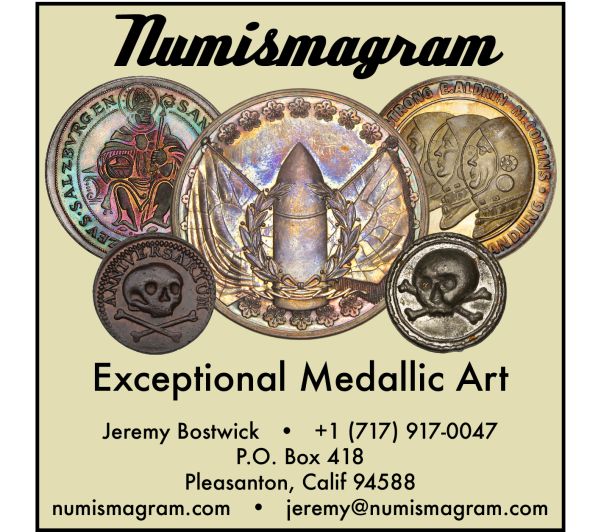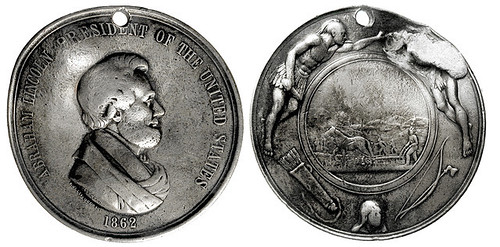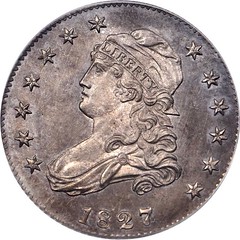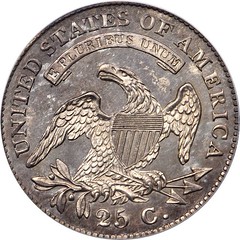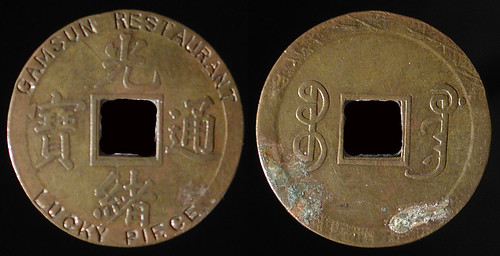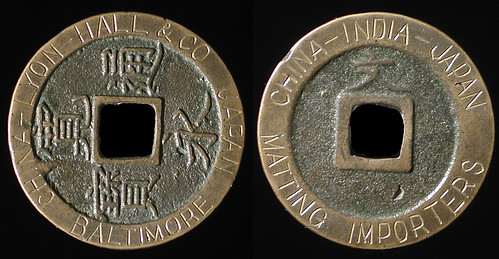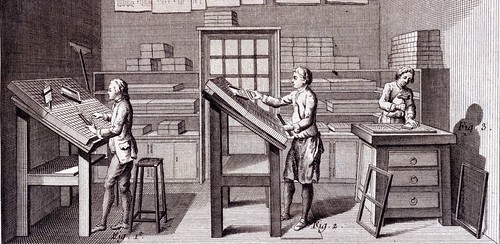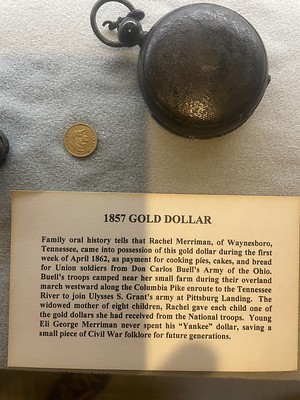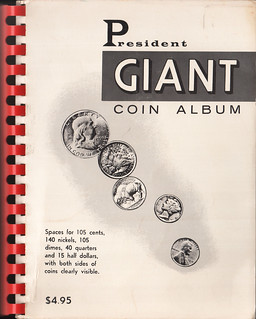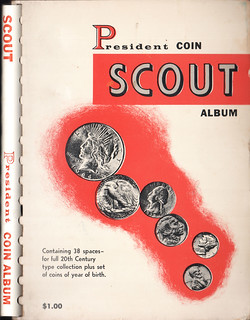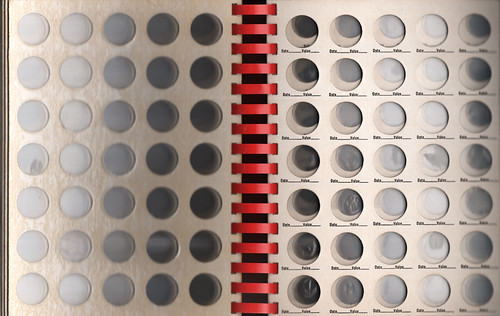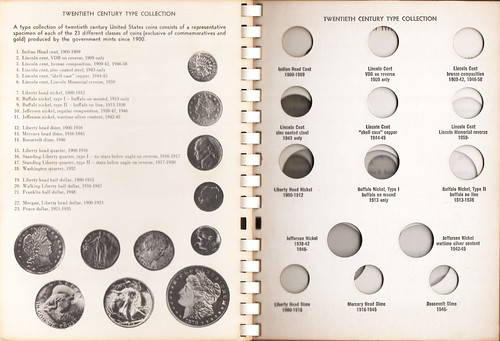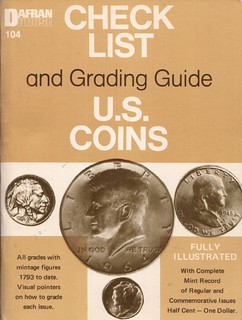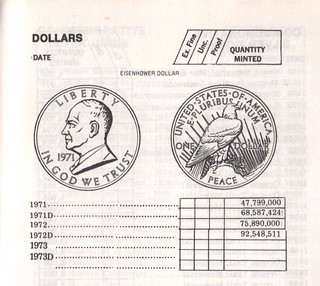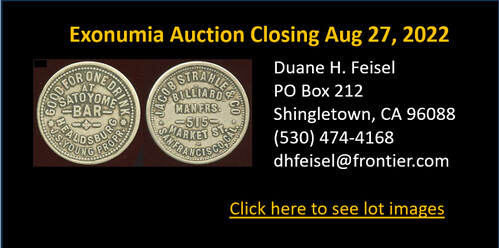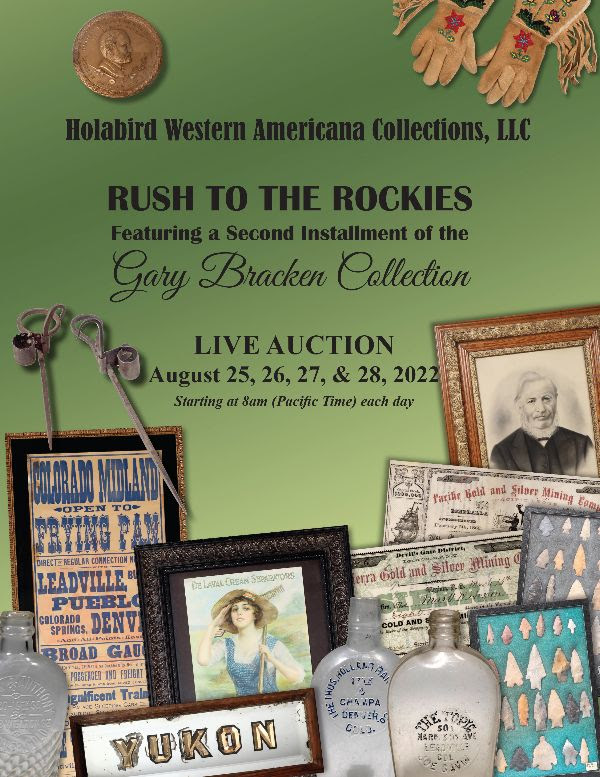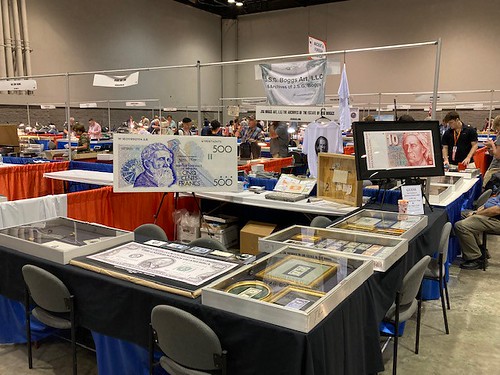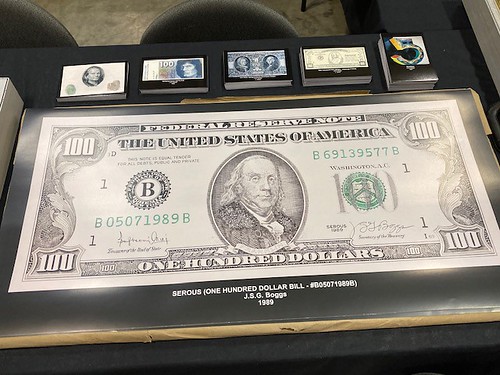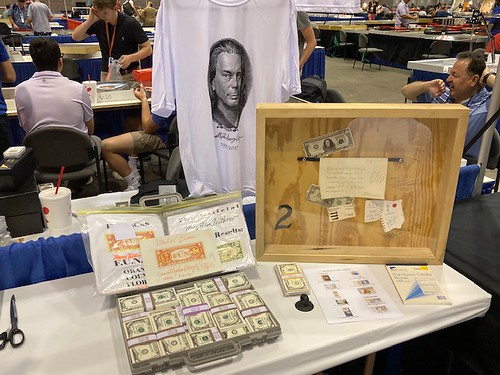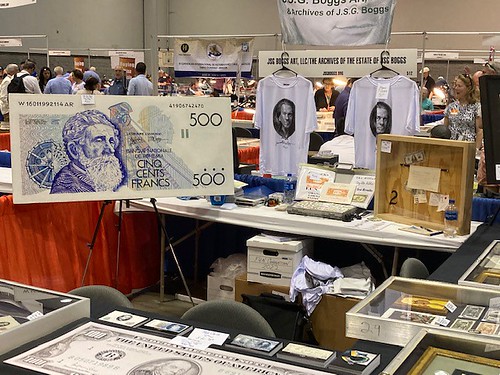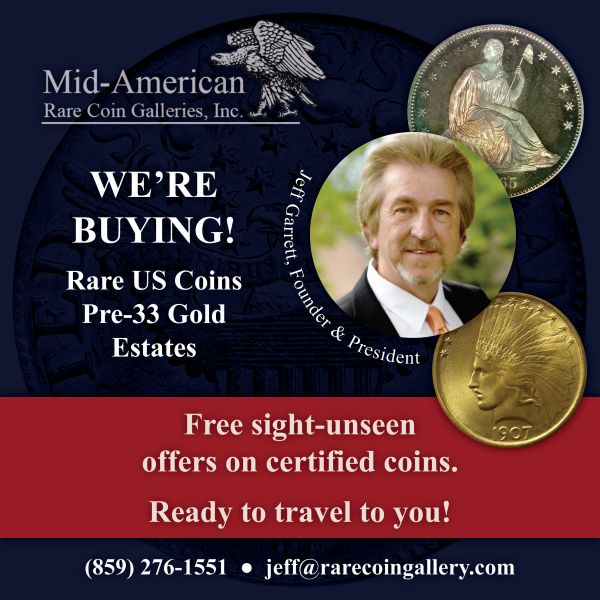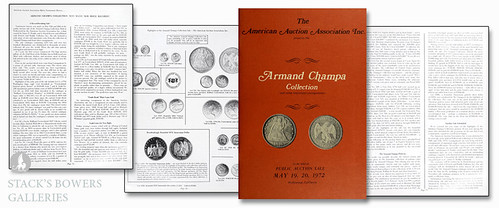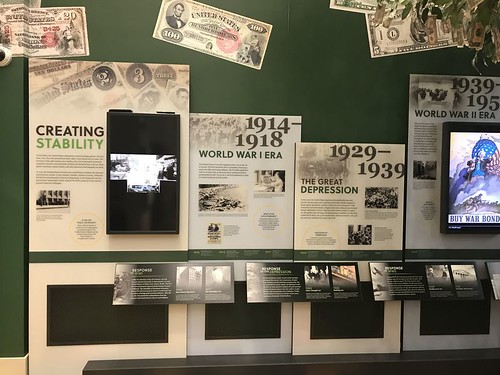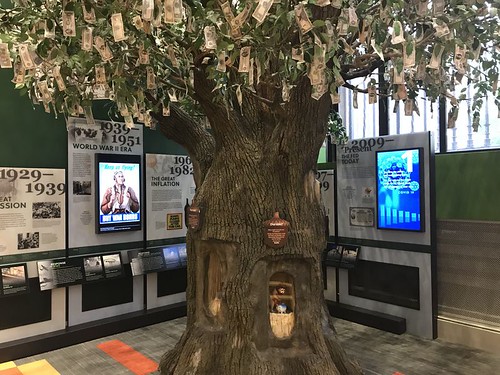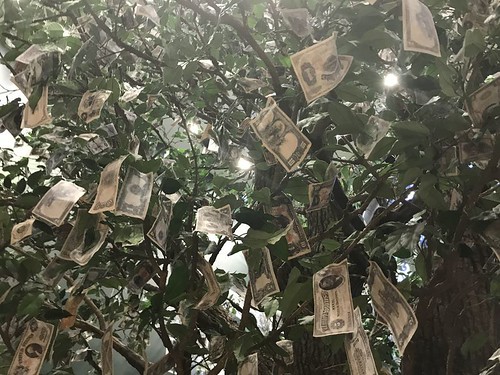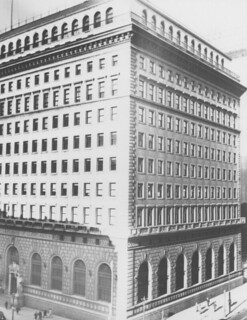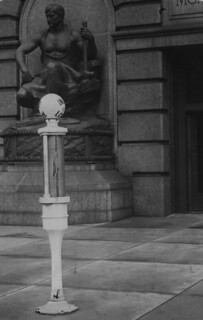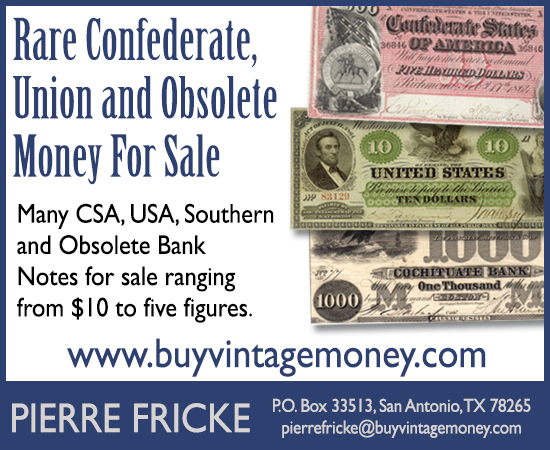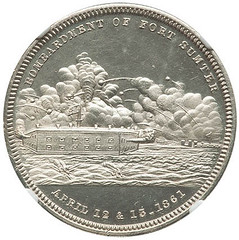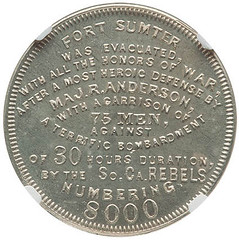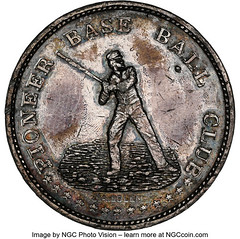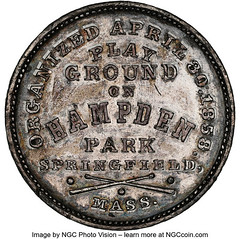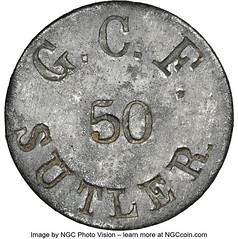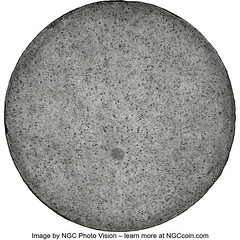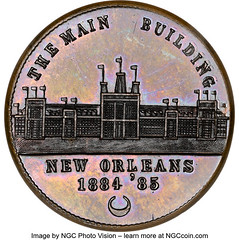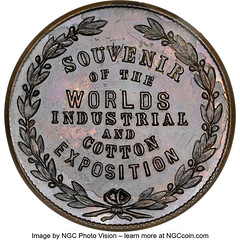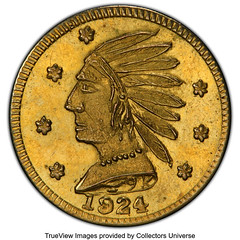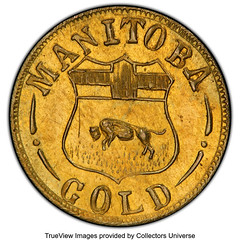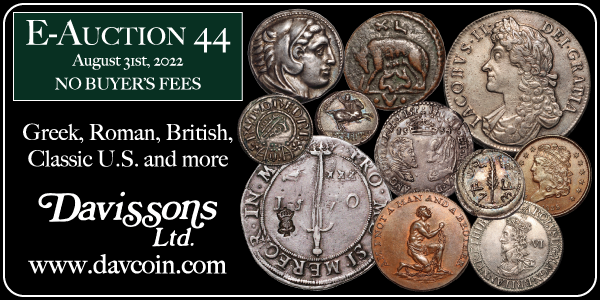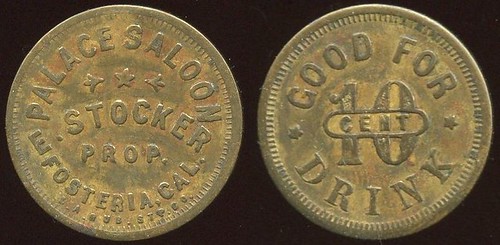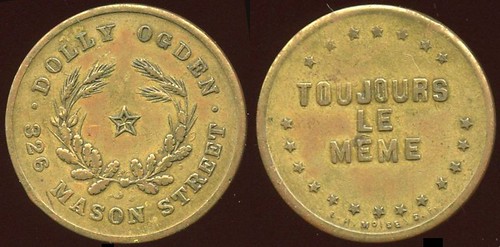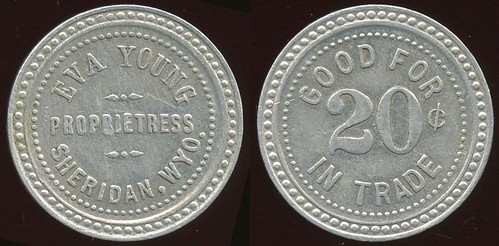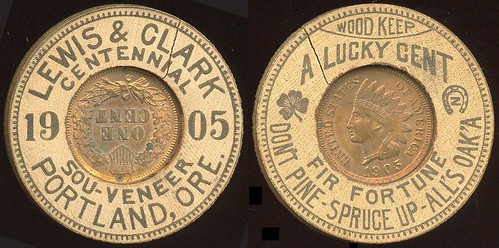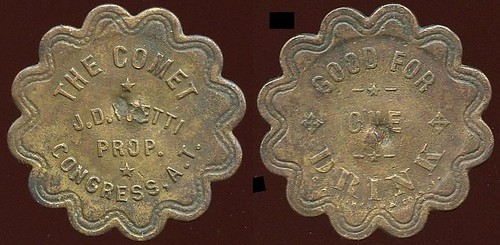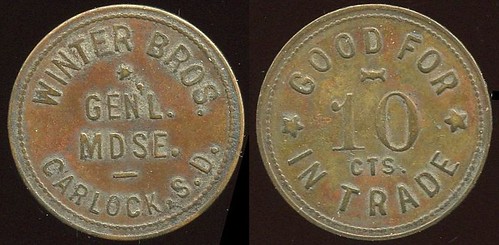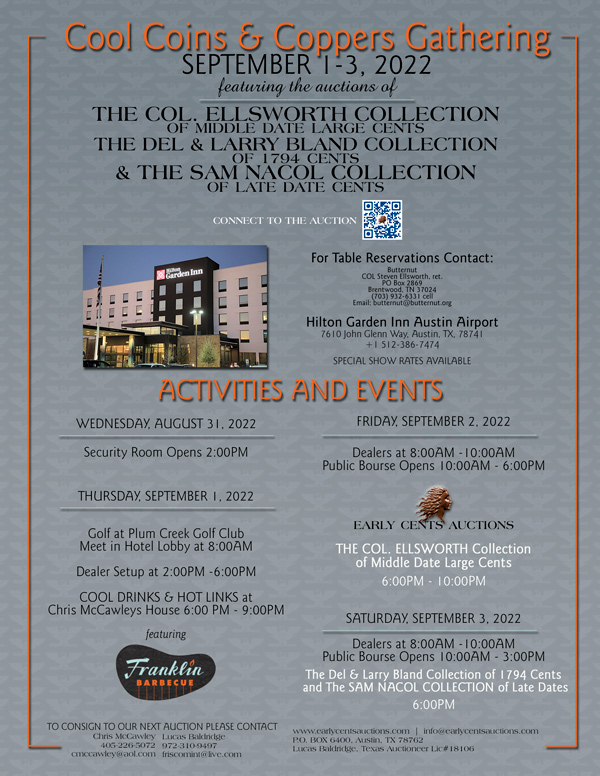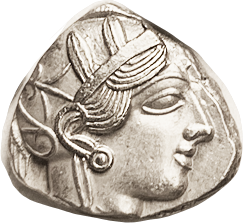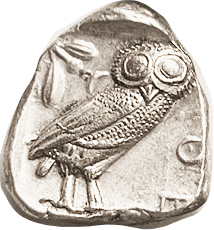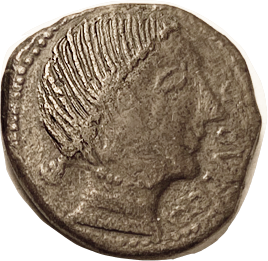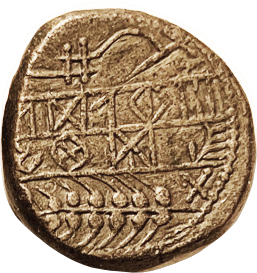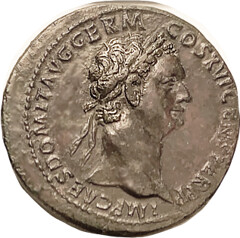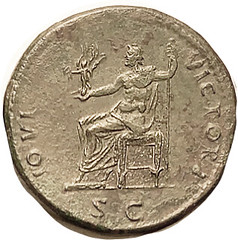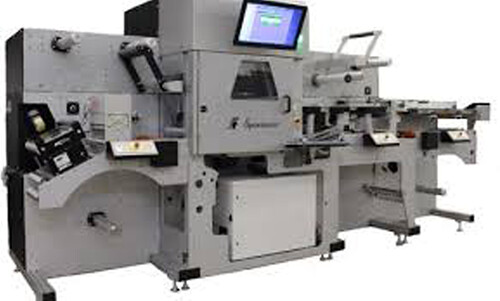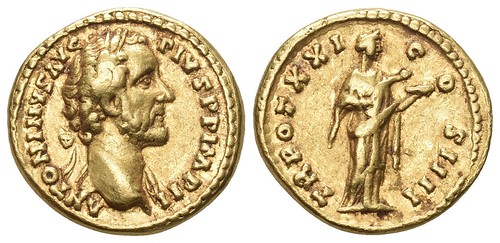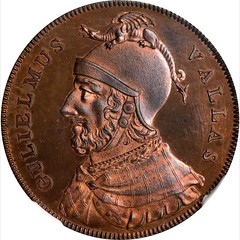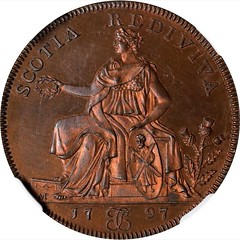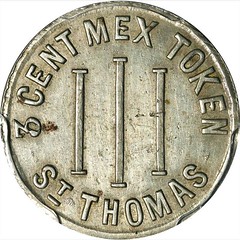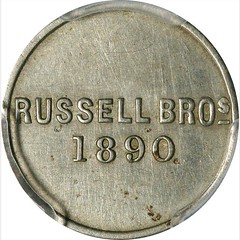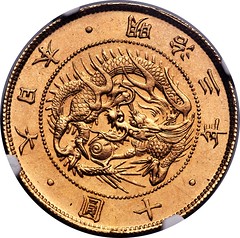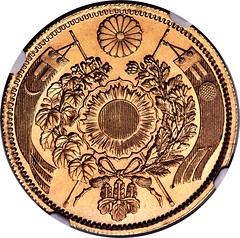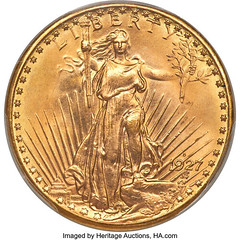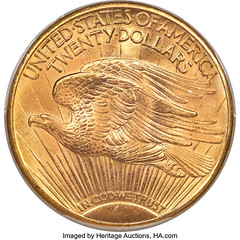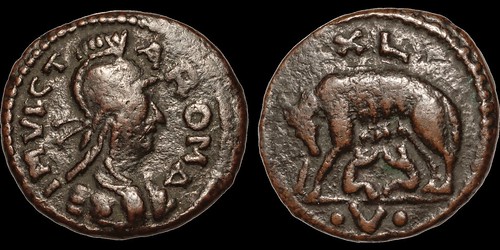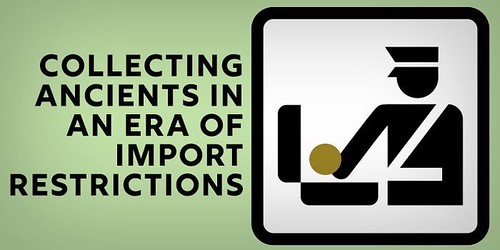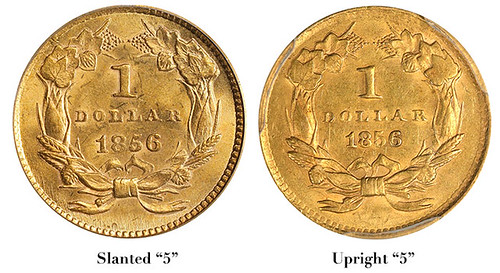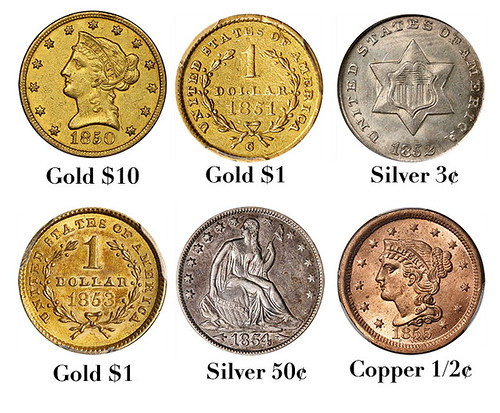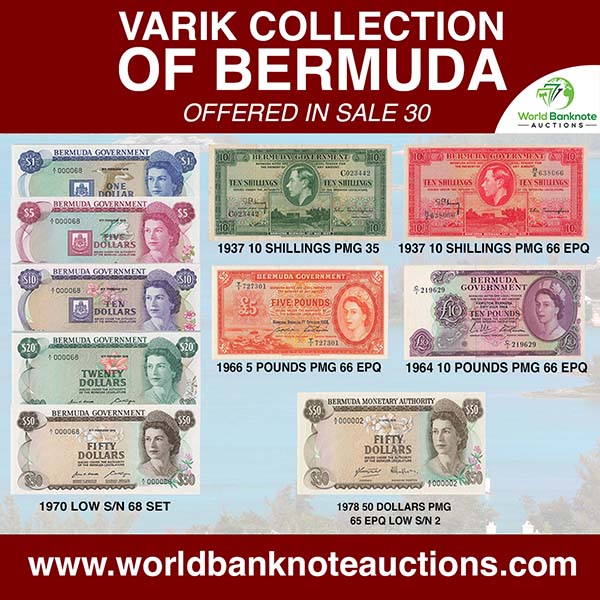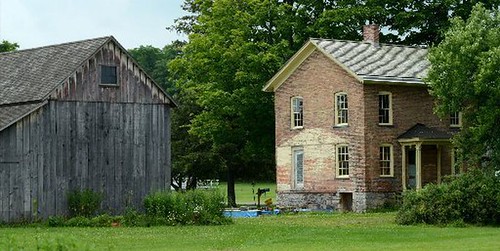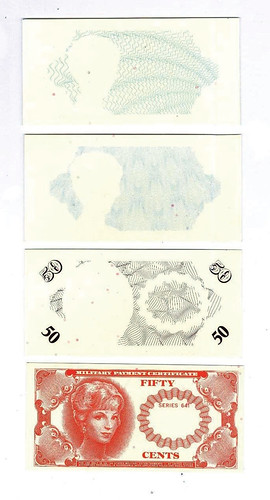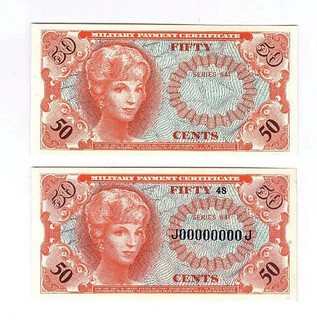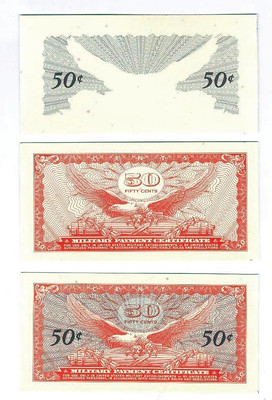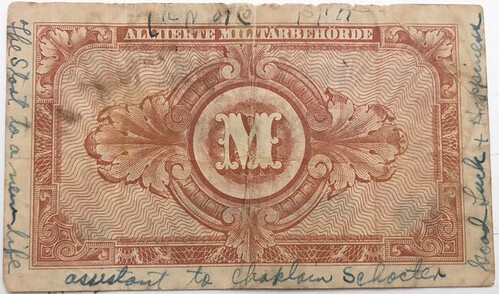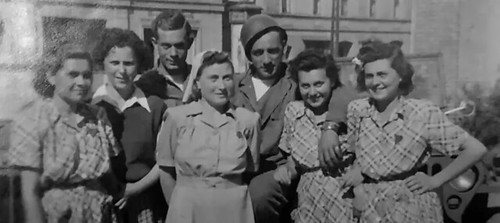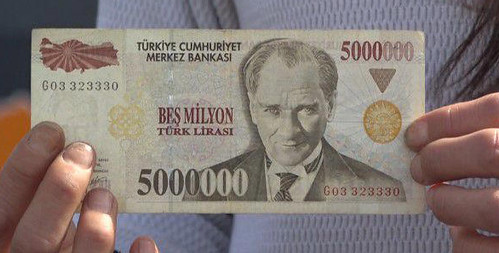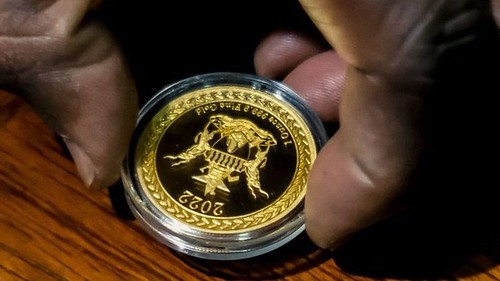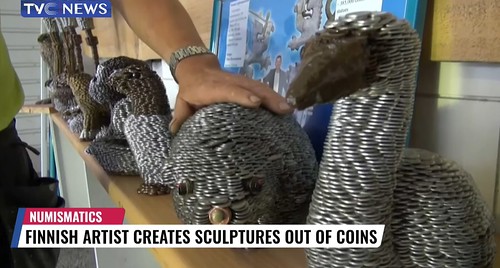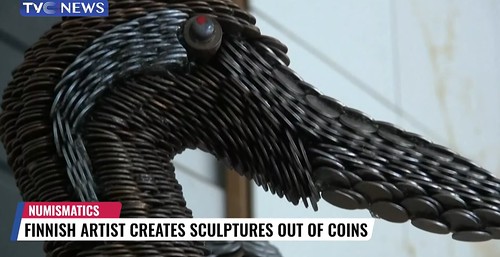
Visit our NBS Sponsors



About UsThe Numismatic Bibliomania Society is a non-profit association devoted to the study and enjoyment of numismatic literature. For more information please see our web site at coinbooks.org SubscriptionsThose wishing to become new E-Sylum subscribers (or wishing to Unsubscribe) can go to the following web page link MembershipThere is a membership application available on the web site Membership Application To join, print the application and return it with your check to the address printed on the application. Print/Digital membership is $40 to addresses in the U.S., and $60 elsewhere. A digital-only membership is available for $25. For those without web access, write to: Charles Heck, Treasurer AsylumFor Asylum mailing address changes and other membership questions, contact Chuck at this email address: treasurer@coinbooks.org SubmissionsTo submit items for publication in The E-Sylum, write to the Editor at this address: whomren@gmail.com BUY THE BOOK BEFORE THE COINSale Calendar |
- WAYNE'S WORDS: THE E-SYLUM AUGUST 14, 2022
- NBS 2022 ANA CONVENTION EVENTS
- KOLBE & FANNING 2022 SUMMER SALE HIGHLIGHTS
- KENNY SAMMUT OFFERS NUMISMATIC LITERATURE
- NEW BOOK: 100 GREATEST CANADIAN COINS AND TOKENS
- BOOK REVIEW: TREASURE!
- NNP ADDS IOWA NUMISMATIC BULLETINS
- CCAC RESOURCES ON THE NEWMAN PORTAL
- VIDEO: CLIFFORD MISHLER AT PAN
- WHITMAN AUTHORS TO SIGN BOOKS AT ANA
- NOTES FROM E-SYLUM READERS: AUGUST 14, 2022
- PRESIDENT COIN COMPANY ALBUMS
- DAFRAN HOUSE COIN CHECKLISTS
- CCAC SEEKS APPLICANTS FOR TWO OPENINGS
- J.S.G BOGGS ESTATE AT 2022 SUMMER FUN
- VOCABULARY TERM: LIMITED EDITION
- THE COLLET AND KOLIT SCALES
- THE FIRST BOWERS AND RUDDY PUBLIC AUCTION
- THE MONEY MUSEUM AT THE CLEVELAND FED
- HERITAGE TOKEN AND MEDAL SELECTIONS
- FEISEL AUGUST 2022 TOKEN SALE HIGHLIGHTS
- ANCIENT JEWISH COINS IN ROBINSON 119TH AUCTION
- NUMISMATIC NUGGETS: AUGUST 14, 2022
- A BRONZE FOLLIS OF ANASTASIUS
- ANCIENT COIN IMPORT RESTRICTIONS
- THE "UPRIGHT 5" GOLD DOLLARS
- HARRIET TUBMAN COMMEMORATIVE COIN ACT
- MPC SERIES 641 50 CENTS PROGRESSIVE PROOF SET
- BANKNOTE RECONNECTS HOLOCAUST SURVIVOR
- DUMPSTER BANKNOTE STIRS VISION OF RICHES
- LOOSE CHANGE: AUGUST 14, 2022
- VIDEO: SCULPTURES MADE OUT OF COINS
Click here to read the thin version on the web
Click here to subscribe
Click here to access the complete archive
To comment or submit articles, reply to whomren@gmail.com
Content presented in The E-Sylum is not necessarily researched or independently fact-checked, and views expressed do not necessarily represent those of the Numismatic Bibliomania Society.
WAYNE'S WORDS: THE E-SYLUM AUGUST 14, 2022
 New subscribers this week include:
Malcolm Mathias and
Elizabeth Mackenzie.
Welcome aboard!
New subscribers this week include:
Malcolm Mathias and
Elizabeth Mackenzie.
Welcome aboard!
Thank you for reading The E-Sylum. If you enjoy it, please send me the email addresses of friends you think may enjoy it as well and I'll send them a subscription. Contact me at whomren@gmail.com anytime regarding your subscription, or questions, comments or suggestions about our content.
This week we open with NBS and Whitman events at the ANA, two numismatic literature sales, one new book, a book review, updates from the Newman Numismatic Portal, and more.
Other topics this week include Canadian coins, the Citizens Coinage Advisory Committee, Clifford Mishler, J.S.G. Boggs, Mark Collet, the Cleveland Fed money museum, auction previews, the Harriet Tubman commemoratives, and sculptures made out of coins.
To learn more about 1794 Large Cents, Chapman catalogues, Mason's Coin and Stamp Collectors' Magazine, the Iowa Numismatic Association, the 2022 NLG Awards Luncheon, a Union Soldier's 1857 gold dollar, President Coin Company coin albums, Mike Kolman, the American Auction Association, the Bombardment of Fort Sumter medal and the coin restoration machine, read on. Have a great week, everyone!
Wayne Homren
Editor, The E-Sylum
NBS 2022 ANA CONVENTION EVENTS
The American Numismatic Association's annual World's Fair of Money convention is upon us. Here's a final reminder of the upcoming NBS events compiled from recent articles. -Editor
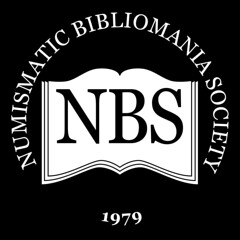 Here are a few highlights of the Numismatic Bibliomania Society's events at the upcoming ANA
Convention in Rosemont the week of August 16th to 20th. Tuesday through Friday the NBS will
host our club table (#730). We hope you will stop by to view a few highlights from Friday's
charity auction, purchase a NBS commemorative coffee mug to support the NBS and, most of
all, share your enthusiasm for the numismatic literature hobby.
Here are a few highlights of the Numismatic Bibliomania Society's events at the upcoming ANA
Convention in Rosemont the week of August 16th to 20th. Tuesday through Friday the NBS will
host our club table (#730). We hope you will stop by to view a few highlights from Friday's
charity auction, purchase a NBS commemorative coffee mug to support the NBS and, most of
all, share your enthusiasm for the numismatic literature hobby.
The NBS Board Meeting will be held on Thursday from 11:30 to 1:00 in room 11. Our Symposium will Immediately follow the Board Meeting at 1:00 also in room 11. We are delighted to have NBS Treasurer and early American coppers authority, Chuck Heck, speaking about his marvelous new book Die States of 1794 United States Large Cents.
Chuck Heck will speak about his new book
Die States of 1794 United States Large Cents
Thursday, August 18 at 1:00PM (Room 11)
NBS General Meeting and
Charity Auction
Friday, August 19 at 11:30AM (Room 12)
The General Meeting will be Friday at 11:30 in room 12. The meeting will feature The Asylum author awards, a video tour of the extensive library of NBS Historian, Joel Orosz and our all- important charity auction. The auction catalog will be posted on the NBS website www.coinbooks.org. David Fanning cataloged the sale and will accept absentee bids by phone (614)256-8915 or email df@numislit.com until 5PM central time Thursday, August 18th.
If your schedule permits, we would like to invite those attending the General Meeting to remain after the formal meeting to enjoy an informal social time. We encourage you to bring a special item from your library to share or just stay for the fellowship. While it will be fun to see what others bring, the goal is to provide an opportunity to connect with your fellow biblio enthusiasts.
Thank you to everyone who has stepped up to serve and support the NBS during our annual events. We look forward to seeing you at the NBS events!
Every year at the ANA convention, NBS holds an auction of donated material to raise funds for the club. Bidding is open to all, and you needn't attend in person. Check out the catalog - there is some great material here, thanks to our generous donors. Pitch in as a generous bidder! -Editor
Each year at the ANA World's Fair of Money, the Numismatic Bibliomania Society conducts a charity auction to raise funds for the organization. All items sold are donated to the NBS by members and 100% of the proceeds go to the NBS treasury.
Absentee bids due by close of day Thursday, August 18 Absentee bids should be sent to David Fanning at df@numislit.com by the end of Thursday, August 18.
The sale will take place on Friday, August 19 as part of the NBS General Meeting, to be held in Room 12 from 11:30 a.m. to 1:30 p.m. Please read the terms of sale before bidding.
Thank you for your support of the NBS!
To view the Benefit Auction Catalogue, see:
https://mcusercontent.com/5c68a72f4948c463818f613c2/files/c7279743-ce57-c0ea-fc8d-b48ae2f6e30d/NBSAuction2022.pdf
Please do stop by the club table to chat with officers and fellow members. With our daughter moving to college this week, I'll be unable to attend the convention this year. Have fun without me, and please submit thoughts and photos to share with readers in future issues of The E-Sylum and our print journal, The Asylum.
Longtime E-Sylum supporter Harry Laibstain published the below remarks in an email to clients today; they completely sum up my own feelings and recommendations about the annual event - go there, have fun, and meet with friends new and old. -Editor
"By the time you read this many of those participating in the ANA will be there or en route. Each Summer, numismatists from all over the world convene in the selected city to join the hoopla known as The Money Show. Sponsored by the ANA, the summer show is the larger of the two they host each year. It is the largest event of the year for Numismatists.
"My First ANA was in Boston in 1982. I had been in the coin business just shy of two years and I was attending a historic show in a historic city. Heady times for a young man I can assure you. I didn't make New Orleans the next year but was in Milwaukee for 84 and every summer ANA since then. The ANA is not just the largest show but the only one that has unique feel. It's so much more than a coin show. It has a cosmic nature. You go to have experiences and memories that you will take with you when you leave. Interactions with new acquaintances that become long-term relationships. Solidifying existing relationships through shared participation. If you haven't attended a summer ANA in the past, I highly recommend you add it to your future to-do list.
"We look forward to seeing as many of our old friends and making as many new friends as we can."
To read earlier E-Sylum articles, see:
NEW BOOK: DIE STATES OF 1794 LARGE CENTS
(https://www.coinbooks.org/v25/esylum_v25n22a04.html)
NBS 2022 ANA CONVENTION EVENT SCHEDULE
(https://www.coinbooks.org/v25/esylum_v25n31a02.html)
2022 NBS BENEFIT AUCTION
(https://www.coinbooks.org/v25/esylum_v25n32a02.html)
KOLBE & FANNING 2022 SUMMER SALE HIGHLIGHTS
Here are some more highlights from the Kolbe & Fanning 2022 Summer Americana sale of numismatic literature. -Editor
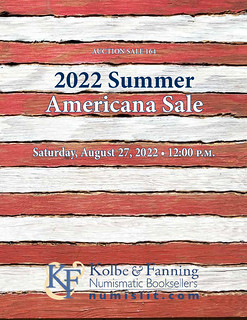 Kolbe & Fanning Numismatic Booksellers will be holding our Summer Americana sale on Saturday, August 27, 2022. Including highlights from the Bourne Library of U.S. numismatic periodicals, the Jim Neiswinter Library of works on U.S. large cents, the Cardinal Collection Library of American numismatic auction catalogues, and other properties, the sale promises to be one of the most important of the year. The sale also features American items featuring ancient and foreign coins, making for a sale that includes something for everybody.
Kolbe & Fanning Numismatic Booksellers will be holding our Summer Americana sale on Saturday, August 27, 2022. Including highlights from the Bourne Library of U.S. numismatic periodicals, the Jim Neiswinter Library of works on U.S. large cents, the Cardinal Collection Library of American numismatic auction catalogues, and other properties, the sale promises to be one of the most important of the year. The sale also features American items featuring ancient and foreign coins, making for a sale that includes something for everybody.
Some highlights of the sale include:
Lot 61: the Fuld set of 86 small-format Chapman catalogues, including a plated Morris sale and other plated catalogues
Lot 152: a large-paper copy of Edward Cogan's important 1869 sale catalogue of the Mortimer Mackenzie collection, with five photographic plates
Lot 179: the extremely rare plated version of Tom Elder's 1910 catalogue of the Ebenezer Gilbert collection, in the original binding
Lot 129: Colonel Green's plated copy of the William Streicher catalogue, one of S.H. Chapman's rarest plated sales
Lot 180: a plated copy of Elder's 1911 catalogue of the William Woodin collection, one of the greatest gold sales of all time
Lots 204: the Stack Family set of the catalogues of Ed Frossard, including 76 catalogues bound in six volumes, four of them with plates
Lot 288: one of 12 copies printed on large paper of the catalogue of the 1865 J.N.T. Levick sale, postponed due to Lincoln's assassination
Lot 302: a complete set of Mason's Coin and Stamp Collectors' Magazine (1867–1872), with an unfolded Photographic Gallery plate
Lot 331: one of ten copies of the deluxe, leatherbound edition of Howard Newcomb's work on the cents of 1801–1803, inscribed by the author
Lot 421 and 422: both printings of the landmark 1851 auction catalogue of the Lewis Roper collection, the first major coin sale in the United States.
Register early to bid online
Bids may be placed via post, email, fax or phone, as well as online. Kolbe & Fanning use Auction Mobility as our third-party online bidding platform. Auction Mobility is an app-based platform allowing users the ability to participate in the sale through phones, tablets and computers. To register for the sale, bidders must go to
bid.numislit.com and sign up. Once you have set up an account, you may browse lots, place advance bids, or participate in the live sale online. Those wishing to participate on their devices can download the Kolbe & Fanning app through the Apple or Google Play Store. The sale is also listed on Biddr and NumisBids.
The printed catalogue of the Summer Americana sale is being mailed to active customers on our mailing list. As international mail speeds have been inconsistent, we encourage our foreign clients to consult the electronic catalogue in case their printed catalogue does not arrive promptly. A PDF of the printed catalogue has been posted to our main website at numislit.com for those who prefer that format. Bids placed via post, email, fax or phone must be received by August 26, the day before the sale, in order for them to be processed. Advance absentee bids may also be placed at any time online at bid.numislit.com. Live internet bidding will be available during the sale itself through the same platform.
Kolbe & Fanning Numismatic Booksellers LLC is a licensed and bonded auction firm in the State of Ohio. For more information, please see the Kolbe & Fanning website at numislit.com or email David Fanning at df@numislit.com. To register for the sale, go to bid.numislit.com. We look forward to your participation.
To read the earlier E-Sylum article, see:
KOLBE & FANNING 2022 SUMMER AMERICANA SALE
(https://www.coinbooks.org/v25/esylum_v25n32a03.html)
KENNY SAMMUT OFFERS NUMISMATIC LITERATURE
In a blog article earlier today, Kenny Sammut notes that he's added a number of numismatic literature lots to his eBay store, with more on the way. Be sure to have a look. -Editor
Right after finishing up my sophomore year at Seton Hall in May, I flew down to Sarasota to begin my second summer internship at NGC. Finished up last week and once again, I had a great time while increasing my numismatic knowledge. Mr. Rick Montgomery, President of NGC, and the entire staff made me feel welcomed. I hope to go back during my Christmas vacation.
During the internship, I had an opportunity to attend one week of the ANA's Summer Seminars. It was my sixth Summer Seminar and I highly recommend all numismatists make it a point to add it to your bucket list of things to do.
While at the Summer Seminar, I purchased approximately 160 books during the ANA Library book sale. Many of those books have been listed on my eBay store. I invite you to take a look.
In regards to my eBay store, I just created a new category - So-called dollars. I have the pleasure of working with a well-known so-called dollar collector and dealer. Each month, I plan on listing up to 80 so-called dollars. The first 20 have just been listed. If you collect so-called dollars, I invite you to visit my store and follow it so you are notified when new listings go up.
Lastly, during the next two weeks before my junior year begins, I will be listing approximately 100 world and US coins, numismatic books, a lot of exonumia, and some bullion each day.
Click here to visit my eBay store: https://www.ebay.com/str/numismaticswithkenny
I am excited to share more than 19,000 items totaling over 21,000 coins, books, and exonumia have been sold since I opened the store three years ago. I truly appreciate all of you who have purchased items.
My latest article will be appearing in The Numismatist next month.
Kenny supports The E-Sylum with his regular ads - be sure to check out his stock frequently. -Editor
NEW BOOK: 100 GREATEST CANADIAN COINS AND TOKENS
Here's the announcement for Whitman's new book on Canadian coins and tokens. Sounds great! -Editor
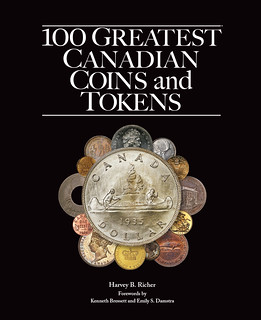 Whitman Publishing announces the United States release of 100 Greatest Canadian Coins and Tokens, by Dr. Harvey B. Richer, at the American Numismatic Association World's Fair of Money in Chicago, August 16, 2022.
Whitman Publishing announces the United States release of 100 Greatest Canadian Coins and Tokens, by Dr. Harvey B. Richer, at the American Numismatic Association World's Fair of Money in Chicago, August 16, 2022.
The 160-page hardcover coffee-table book debuted in July at the Royal Canadian Numismatic Association convention in Ottawa. In conjunction with the RCNA show, the Bank of Canada held a reception at its Money Museum with a display of many of the 100 Greatest
coins from Richer's book. The exhibit included, for the first time in history, all three of the existing 1911 Canadian pattern silver dollars on public display.
In 100 Greatest Canadian Coins and Tokens, Richer explores Canadian money that has captured the imagination of collectors for generations. He includes such factors as historical significance, rarity, value, popularity, beauty, and innovation.
Instead of listing the 100 Greatest from 1 to 100, Richer presents the coins and tokens in a chronological narrative. He illustrates historical connections in the development of Canadian money and numismatics, from the earliest examples of wampum all the way to coinage after Confederation, when Canada had its own mint and was a member of the British Commonwealth of Nations. He gives mintages and quantities known, physical details, auction and private-sale data, market values, museum notes, rarity information, and other fascinating background.
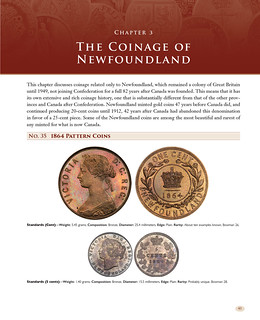 Kenneth Bressett, Editor Emeritus of the Guide Book of United States Coins (the
Kenneth Bressett, Editor Emeritus of the Guide Book of United States Coins (the Red Book
), says, Professor Richer has not only laid this intriguing meal before us, but has added to it a concise history of Canadian numismatic items ranging from primitive trade beads to some of the Royal Canadian Mint's latest innovations, designs, concepts, and assorted novelties. If you already collect Canadian coins, Harvey Richer's book will refresh your interest and bring back wonderful memories. If you're new to the hobby, you'll be inspired to begin a richly satisfying lifelong journey.
Emily S. Damstra, an award-winning designer of Canadian and U.S. coins, says, Richer's thoughtfully guided tour of the 100 Greatest Canadian Coins and Tokens is a marvelous journey.
100 Greatest Canadian Coins and Tokens is available from booksellers and hobby shops nationwide, and online (including at www.Whitman.com), for $34.95. The book can also be borrowed for free as a benefit of membership in the ANA, through the Dwight N. Manley Numismatic Library.
100 Greatest Canadian Coins and Tokens
By Harvey B. Richer; forewords by Kenneth Bressett and Emily S. Damstra.
ISBN 794849830. Hardcover, 10 x 12 inches, 160 pages, full color.
Retail $34.95 U.S.
BOOK REVIEW: TREASURE!
Doug Nyholm published this review of Peter Jones' Treasure! in the August 2022 issue of The Mint Master, which he edits for the Utah Numismatic Society. With permission, we're republishing it here. -Editor
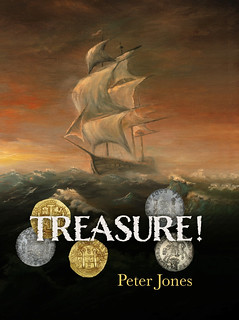 I recently ordered the book
I recently ordered the book Treasure
by Peter Jones. This is a different type
of book than I normally acquire but the
initial information about the subject
intrigued me. Sometimes it is difficult
to order a book without seeing even a
single page. I often wonder about not
only the content but the quality of
publishing and printing.
When the book arrived I showed it to
my wife and said This book is a
gem!
It truly was great and I have
barely set it down since opening the
package. Most importantly is the content which I said is different from your typical coin or numismatic book. As
the book states It is a collectors numismatic journey into maritime history.
Discussed are 75 maritime shipwrecks from the 1500's to early 1900. Also covered is the history of shipping
and shipwreck salvage.
The writing technique is a bit different but easily readable separated by tidbits of information rather than pages and standard paragraphs. It is filled with numerous color images and many full page images of recovered coins. It has a wealth of information and some could consider it a coffee table book. It consists of 398 pages in 8x11 format. It is full color and printed on glossy paper. Retail price is listed at $99 but I found my copy discounted on eBay for $77 including tax and shipping. If this subject is of interest to you I would highly recommend this book.
To read the earlier E-Sylum article, see:
NEW BOOK: TREASURE!
(https://www.coinbooks.org/v25/esylum_v25n13a05.html)
NNP ADDS IOWA NUMISMATIC BULLETINS
Newman Numismatic Portal Summer intern Kellen Hoard submitted these thoughts on one of NNP's recent additions - newsletters of the Iowa Numismatic Association. Thanks.
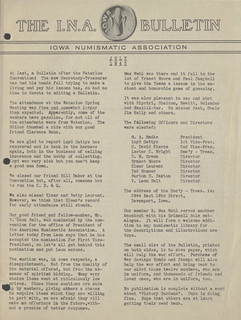 I take great personal pleasure in learning about the history of American numismatics, the (often quite unusual) people who shaped it, and the organizations which were integral to forming the hobby as we know it today. It was therefore with great curiosity that I examined a recent addition to the Newman Numismatic Portal: the Iowa Numismatic Association newsletters from 1942-1946.
I take great personal pleasure in learning about the history of American numismatics, the (often quite unusual) people who shaped it, and the organizations which were integral to forming the hobby as we know it today. It was therefore with great curiosity that I examined a recent addition to the Newman Numismatic Portal: the Iowa Numismatic Association newsletters from 1942-1946.
I hoped when first reading through that it might provide some slice of insight into the state of the hobby as it was in the 1940s, and it did. But what I found more exciting were the lessons, of sorts, which modern numismatists might glean from its pages. The following is a list of some such enlightenment I received from these newsletters.
DO:
-
Shamelessly promote the most famous numismatists you know. The INA newsletter made every effort to share the organization's notable members, including one instance where it was noted that
by the way, do you know that nine of the thirteen members of [the ANA board and staff] are members of the INA?
The INA roster was replete in various instances with such names as B. Max Mehl, J. Hewitt Judd, Lee Hewitt, Harry X. Boosel, Morton Stack, Abe Kosoff, R.S. Yeoman, and M. Vernon Sheldon. -
Capitalize upon numismatists' compulsion for competition to benefit the greater good. See one such provoking question in the March 1944 issue:
do you know that some other state beat Iowa last year in the number of books borrowed by ANA members from the library?
-
Discuss the intersection of agriculture and numismatics extensively. See December 1944:
Paul Campbell was there! Guess Paul must have finished husking the corn he was so busy planting that he could not get to Cedar Rapids in the spring. That was the first convention Paul had ever missed, too.
DON'T:
- Share the addresses of every club member. The INA certainly didn't hesitate to detail the home locations of theirs in several different issues. But I guess things might have been more easy-going then. We have Whitepages online now, anyway.
- Accept cigarettes in lieu of membership dues, as INA Secretary Lewis M. Reagan did.
-
Publicly blame the bidders for making your own convention auction a
disappointment
withridiculously low prices.
Whenever auctions are lackluster nowadays, we just blame the catalogers (but never Mark Borckardt).
See the newsletters here:
https://archive.org/details/inanewsbulletin1/page/n3/mode/2up
CCAC RESOURCES ON THE NEWMAN PORTAL
Newman Numismatic Portal Summer intern Kellen Hoard also notes NNP resources relating to the Citizens Coinage Advisory Committee (CCAC). -Editor
As a spot on the Citizens Coinage Advisory Committee (CCAC) opens up to the general public, you may be considering applying for the position. But as we—all readers of The E-Sylum, but particularly the bibliomaniacs among us—are well aware, it pays dividends to do your research (buy the book before…
). In this instance, if you plan to apply, it is worthwhile to utilize the diverse offerings on the Newman Numismatic Portal in order to conduct that research and subsequently strengthen your application.
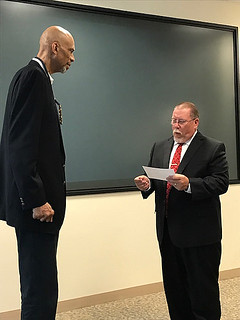 A simple NNP search of
A simple NNP search of CCAC
reveals materials in a variety of mediums which may improve your expertise in the organization. Learn about its official activities via Coin World and inside perspectives from E-Sylum archives. Listen to audio of former CCAC member Heidi Wastweet to understand the experience of being a member. Read official CCAC reports to glean insight into accompanying responsibilities. View dozens of images related to the group to see if the other members seem like pleasant enough people. Read biographies of past and present members to gauge whether you are the right fit. The only thing you won't find there is the application (but we at the NNP are confident in your ability to find that elsewhere on the internet).
Image: Past CCAC member and NBA star Kareem Abdul-Jabar is sworn in in this picture from the NNP E-Sylum archive. This could be you!
More than 1,300 resources await you, future CCAC member. Find them here:
https://nnp.wustl.edu/library/searchwithterms?searchterm=CCAC
An article elsewhere in this issue discusses the currently open positions. -Editor
VIDEO: CLIFFORD MISHLER AT PAN
These are selections from the David Lisot Video Library that feature news and personalities from the world of coin collecting. David has been attending coin conventions since 1972 and began videotaping in 1985. The Newman Numismatic Portal now lists all David's videos on their website at:
https://nnp.wustl.edu/library/multimediadetail/522852
Here's one of Clifford Mishler speaking at the May 2022 PAN Show banquet. -Editor
Cliff Mishler: Thoughts About Numismatics
Clifford Mishler, Governor, American Numismatic Association
David Lisot, Video Producer, CoinTelevision.com
May 20, 2022.
Clifford Mishler, former President, Krause Publications, speaks to Pennsylvania Association of Numismatists Coin Show Banquet 2022 and shares his thoughts about the coin hobby.
25:53
David adds:
"The PAN Convention prides itself on having important people to the hobby of numismatics speak at their gatherings. Clifford Mishler brings years of understanding to his audience as he shares what he thinks numismatics is all about."
An excerpt of the video is available for viewing on the Coin Television YouTube Channel at:
https://www.youtube.com/watch?v=BtLwRLNOfqY
WHITMAN AUTHORS TO SIGN BOOKS AT ANA
This press release from Whitman Publishing announces a book signing event at this month's ANA show. Great opportunity to meet some of today's top authors! -Editor
Coin collectors have a chance to meet hobby legends Kenneth Bressett and Jeff Garrett, and the newest Whitman Publishing author, Harvey B. Richer, at the American Numismatic Association World's Fair of Money, held August 16–20, 2022. Whitman authors will visit with collectors and sign copies of their books at the Whitman booth at the Donald E. Stephens Convention Center in Chicago (Rosemont), Illinois.
Ken Bressett is editor emeritus of the Guide Book of United States Coins (popularly known as the Red Book
), which celebrates its 76th edition this year; the Handbook of United States Coins (the wholesale-pricing Blue Book); and Mega Red (the 1,504-page expanded version of the Red Book). More than 25 million copies of the Red Book have been sold since it debuted in 1946. Many hobbyists collect the Red Book itself, including varieties, special editions, and autographed volumes.
Among Bressett's newest titles are A Penny Saved: R.S. Yeoman and His Remarkable Red Book, a richly illustrated volume that tells the history of Whitman Publishing and the Red Book, along with a biography of its original author (R.S. Yeoman), and an autobiography of Bressett himself. His latest book, Bible Lore and the Eternal Flame, is an archaeological study of the Old and New Testaments, from the earliest cuneiform writing to pottery, oil lamps, glass, and—of course—coins and other money.
Jeff Garrett, a professional numismatist and former president of the ANA, took over from Bressett as senior editor of the Red Book and the Blue Book in 2018. He also serves as valuations editor of Mega Red, which is edited by another hobby legend, Q. David Bowers.
Harvey B. Richer's new book 100 Greatest Canadian Coins and Tokens enjoys its United States unveiling at the ANA show, after debuting in July along with an impressive Bank of Canada exhibit at the Royal Canadian Numismatic Association convention in Ottawa.
Autograph sessions at the Whitman booth give collectors a unique chance to chat in person with some of our favorite hobby writers,
said Whitman publisher Dennis Tucker. We invite collectors to bring their cameras and take pictures. The ANA World's Fair of Money is a place to make wonderful memories.
Whitman Publishing is located at booth #1900, right next to the United States Mint display. Whitman is the Official Supplier of the American Numismatic Association. As a benefit of membership in the ANA, members receive 10% off all Whitman purchases.
NOTES FROM E-SYLUM READERS: AUGUST 14, 2022
On Indian Peace Medal Recipients
Nathan Markowitz writes:
"Paul Horner asks a question to which all interested in Indian Peace Medals would like an answer! Simply put, I have traced a number of IPMs and the information regarding issuance is limited as is subsequent provenance information. For example, the journals of Lewis and Clark enumerate specific awards but the recipients are hard if not impossible to trace historically. They clearly documented award events but accurate names and tracing the medals longitudinally is tough; I know of only two from the Lewis and Clark expedition traced from recipient to recent times.
"Other sources might include any records from the official offices of the Indian departments but I have not reviewed them. I am also interested not only in who received the medals but how they felt about the "awards". I welcome any further insight beyond the standard texts and the excellent auction research done in Ford and subsequent auctions."
Alan V Weinberg writes:
"As to there possibly being one or even several sources for the names and dates of recipients of silver Indian Peace medals, there is no such thing. There were as many as three different sizes of silver presentation medals and the smaller ones were given to less prominent chieftains and even warriors whose names and dates of presentation were totally inconsequential at the time. Not only that , but in many cases they were given in remote geographic locations where writing instruments / paper were not available.
"Any documentation
of a name of an Indian Peace medal recipient, with a very few exceptions, would have to come from the proud Native American recipient himself or his immediate descendants and , in some cases , those identifications were primitively carved or engraved on the silver medals themselves"
Thanks, everyone. This is unfortunate, but makes sense given the situation and times. -Editor
To read the earlier E-Sylum article, see:
NOTES FROM E-SYLUM READERS: AUGUST 7, 2022 : Indian Peace Medal Recipient List Sought
(https://www.coinbooks.org/v25/esylum_v25n32a16.html)
More on the Joseph Reakirt Collection
Dave Hirt writes:
"I'm still processing all the information on the Reakirt and his coins. I have a priced and named catalog of the Mickley sale, and Reakirt bought the three piece 1827 proof set for $160. I think that set is one of the most desirable items ever struck by the US Mint. How it could remain off the market for 100 years, and no one could be curious about its whereabouts is a mystery to me."
Alan V Weinberg writes:
"I actually flew down to Athens GA to examine and bid on the Joseph Reakirt collection in 1963 and was greeted and had dinner with the Reakirt descendant family. I did acquire a gem proof 1857 flying eagle cent for, if memory serves, $750 (after calling Norman Stack for advice). I understood the Norweb family acquired many of the remaining coins including an original 1827 quarter, so if Kosoff allegedly acquired much (not all) of the collection, he was acting as an agent for Norweb."
Thanks, everyone. What a great collection. Without a named public sale catalog to memorialize it, it's largely forgotten today. Linked below is the August 2021 Stack's Bowers ANA auction lot description. The coin sold for $588,000. -Editor
To read the complete lot description, see:
1827/3/2 Capped Bust Quarter. Original. B-1. Rarity-7. Curl Base 2 in 25 C. Proof-65 Cameo (PCGS). CAC.
(https://auctions.stacksbowers.com/lots/view/3-S47VP/182732-capped-bust-quarter-original-b-1-rarity-7-curl-base-2-in-25-c-proof-65-cameo-pcgs-cac)
To read the earlier E-Sylum article, see:
NOTES FROM E-SYLUM READERS: AUGUST 7, 2022 : More on the 1963 "Famous Old Collection"
(https://www.coinbooks.org/v25/esylum_v25n32a16.html)
2022 NLG Awards Luncheon
Patrick Ian Perez is the Executive Director of our sister organization the Numismatic Literary Guild. He writes:
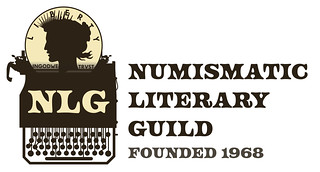 "The NLG Awards Luncheon will take place at the upcoming World's Fair of Money on Thursday, August 18th promptly at 12:30 in Room 22. All active NLG members, especially those who made submissions, are invited. The event should take an hour and a half."
"The NLG Awards Luncheon will take place at the upcoming World's Fair of Money on Thursday, August 18th promptly at 12:30 in Room 22. All active NLG members, especially those who made submissions, are invited. The event should take an hour and a half."
Many NBS members are also members of NLG. Good luck in the NLG Awards competition! -Editor
To read the earlier E-Sylum article, see:
NEW NLG EXECUTIVE DIRECTOR PATRICK IAN PEREZ
(https://www.coinbooks.org/v25/esylum_v25n19a17.html)
For more information, see:
http://www.nlgonline.org/
1922 U.S. Mint Die Records Sought
Tom DeLorey writes:
"Apropos Roger W. Burdette's plea that our illustrious members check their libraries for the missing Denver Mint die registry book for the years 1926 to 1938 (or so,) I would like to ask if by any chance any of our members have access to the Philadelphia and/or San Francisco Mint die records for 1922, plus or minus a few years?
Has anybody ever made a FOIA request for die information from either mint for this time period? If so, could you share the results with me?"
Can anyone help? -Editor
To read the earlier E-Sylum article, see:
NOTES FROM E-SYLUM READERS: AUGUST 7, 2022 : Missing: Denver Mint Coinage Dies Volume
(https://www.coinbooks.org/v25/esylum_v25n32a16.html)
More on Counterstamped Chinese Cash Coins
Regarding the Nanking Inn coin discussed recently,
Michael Wehner writes:
"The late Jerry Schimmel listed and pictured the reverse of this particular Nanking Inn counterstamped cash coin on page 81 of his book, Chinese American tokens from the Pacific Coast. He was not able to locate this establishment definitively but felt it was a US piece, possibly from a restaurant in Dayton, Ohio (page 116). A similar, but self-attributed piece, pictured here from the Lyon Hall & Co. in Baltimore reveals that counterstamping Chinese cash coins was practiced in the US (page 71). While this piece here was from his collection, Jerry actually illustrated a different example of the counterstamp on a cash coin identified as Yunnan (1796-1820). Rulau and Brunk also listed this counterstamp and suggest an 1880-1890 usage. Also on page 71, he lists this Gamsun Restaurant counterstamp as being from Boston and on a later (1890-1908) Guangdong cash. Jerry felt it was likely was counterstamped prior to World War 2 (page 111).
"I suspect that the host coin was likely random and depended on whatever the counterstamper could obtain. Also, while the bulk of Jerry's listings of Chinese American tokens are attributed or at least manufactured in California, Oregon and Washington State, he did not list any counterstamped cash coins from the western US."
Thank you! Interesting to see these. -Editor
To read the earlier E-Sylum articles, see:
NUMISMATIC NUGGETS: JULY 24, 2022 : Nanking Inn Counterstamp
(https://www.coinbooks.org/v25/esylum_v25n30a20.html)
NOTES FROM E-SYLUM READERS: JULY 31, 2022 : Counterstamped Chinese Cash Coin Identified
(https://www.coinbooks.org/v25/esylum_v25n31a09.html)
NOTES FROM E-SYLUM READERS: AUGUST 7, 2022 : Thanks to Ted Puls
(https://www.coinbooks.org/v25/esylum_v25n32a16.html)
Blank vs. Uniface
Duane Feisel writes:
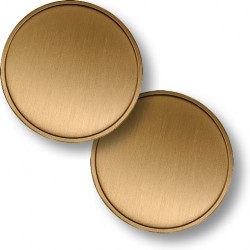 "I've been trying to inform certain token collectors the meaning of
"I've been trying to inform certain token collectors the meaning of
blank
and uniface
as it applies to tokens – having a hard time! Does Dick Johnson's Encyclopedia of Coin and Medal Terminology have those terms defined?"
Yes - entries for Blank and Uniface linked below. -Editor
Duane adds:
"Thanks for these references.
"In my way of thinking, a token/medal with no striking on the reverse (struck one side only), the reverse is blank." However, if the reverse is struck with a border but no other marks/designs, then is what I call "uniface."
"Seems like I have seen such definition provided somewhere!"
To read the Newman Numismatic Portal dictionary entries, see:
Blank
(https://nnp.wustl.edu/library/dictionarydetail/510404)
Uniface
(https://nnp.wustl.edu/library/dictionarydetail/516963)
Lecture: Benjamin Franklin and the Making of Modern Money
"The Library Company of Philadelphia is holding a program that is sure to be of interest to some of us.
"It will be "Benjamin Franklin and the Making of Modern Money," to be held Tuesday, August 16th, with an in-person reception at 6:30 and a lecture beginning at 7:00 pm. It is a hybrid event that will cost $10 to participate. Here is the published blurb:
"In Philadelphia, we tend to think of Benjamin Franklin's legacy in terms of the institutions (like ours) that he helped to establish. In his lifetime, he was known mostly as a scientist, as the man who stole lightning from the skies.
Today, around the world, Franklin is probably most recognized as the face on the $100 bill. His place there signifies that beyond his role as a diplomat, legislator, and scientist; he was very concerned with money itself and how it helps an economy function. Library Company of Philadelphia Edwin Wolf 2nd Director Michael Barsanti, Ph.D., will talk about Franklin and money – its role in his life and business, his arguments for the use of paper money, his innovations for making paper money more secure – but also how Franklin's work with money anticipated the current development of cryptocurrency."
Thank you. Remember, this is a hybrid physical/virtual members-only event, so interested readers can participate remotely. Just be sure to register and become a member if you aren't one already. Cost? One Benjamin. -Editor
For more information, see:
Director's Hour with Michael Barsanti: Benjamin Franklin and the Making of Modern Money
(https://librarycompany.org/calendar/)
Join & Renew Membership Online!
(https://librarycompany.org/development/development-member-form/)
Union Soldier's 1857 Gold Dollar
Nate Fick writes:
"I saw this exhibit yesterday in the museum at Shiloh National Battlefield in Tennessee. Thought your readers may find this interesting!"
Absolutely. Thank you! -Editor
For more information, see:
Shiloh Battlefield Visitor Center
(https://www.nps.gov/shil/planyourvisit/index.htm)
PRESIDENT COIN COMPANY ALBUMS
Researcher and author Dave Lange submitted these notes and images about coin albums of the President Coin Company (not to be confused with Joe Levine's later Presidential Coin and Antique Company). Thank you! -Editor
Pete Smith's piece on Burton Hobson made mention of his being the sales manager for President Coin Company in 1961. This immediately rang a bell, as that company produced a line of coin albums bearing a 1961 copyright date. There was a volume for each denomination, but these did not list dates and mints at the openings, as was the custom for most lines. Instead, the albums were more like stock books, with a pair of horizontal lines under each opening for the user to write the "Date" and "Value" of his coins. The page backings were of clear cellophane, permitting the user to see both sides of each coin, and the albums were comb bound to lie flat when open. Also included in this line was the President "GIANT" album, which assembled all of the various pages of the individual albums under one cover.
Another entry was the President "SCOUT" album, which did have labels at the opening for each type of 20th Century USA coin, excluding gold. The name SCOUT may have been a reference to the requirement of Boy Scouts that they complete a 20th Century type set to earn their merit badge for coin collecting. This requirement was enacted in the early 1950s, at which time Whitman introduced its 20th Century coin folder for just this purpose.
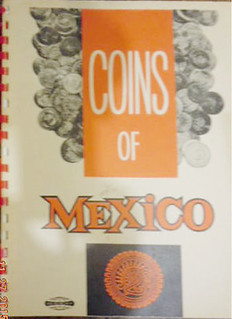 Like the Whitman entry, the SCOUT type folder also includes openings for the user to collect a set of coins of his birth year, which was also a requirement for the coin collecting merit badge. Interestingly, however, the President line's album has openings for all five denominations from each mint, which the Whitman does not and which the Boy Scouts didn't require.
Like the Whitman entry, the SCOUT type folder also includes openings for the user to collect a set of coins of his birth year, which was also a requirement for the coin collecting merit badge. Interestingly, however, the President line's album has openings for all five denominations from each mint, which the Whitman does not and which the Boy Scouts didn't require.
My collection of these albums is complete with one big exception. I've seen images of a President book titled Coins of Mexico. While not a coin album, its similar graphics and comb binding make it a natural tie-in item that I'd like to have.
I'm including several scans of my own President albums, as well as a poor photo found online of the Mexican book.
To read the earlier E-Sylum article, see:
BURTON HAROLD HOBSON
(https://www.coinbooks.org/v25/esylum_v25n32a21.html)
DAFRAN HOUSE COIN CHECKLISTS
Dave Lange also submitted information on Dafran House coin checklists. Would anyone have more information on the firm? -Editor
I bought a group of mostly undistinguished coin books to get the item in these scans. It's a USA coin check list and grading guide of the sort intended for the non-numismatic market. These items once were commonplace at supermarket check-out counters but are seldom seen today.
I don't know anything about who was behind the publisher, Dafran House, but it was located at 42 W. 39th Street in NYC and likely produced similar, inexpensive books about other subjects that would result in impulse purchases while waiting on line. Dating to 1973 (the mintages are complete through 1972 with the 1973 dates being in larger print), the most curious page is that for Eisenhower Dollars. An earlier edition evidently came out before the actual design of that coin was known, and this still hadn't been updated two years later.
CCAC SEEKS APPLICANTS FOR TWO OPENINGS
The Citizens Coinage Advisory Committee (CCAC) is seeking two new members. The call seeks applicants for seats to represent interests of the general public, and for experience in the medallic arts or sculpture. Here are the announcements published August 10th in the Federal Register. The application deadline is 5:00 p.m. (EDT), September 2, 2022. -Editor
Pursuant to United States Code, Title 31, section 5135(b), the United States Mint is accepting applications for appointment to the Citizens Coinage Advisory Committee (CCAC) as the member specially qualified to serve on the CCAC by virtue of their experience in the medallic arts or sculpture. The CCAC was established to:
Advise the Secretary of the Treasury on any theme or design proposals relating to circulating coinage, bullion coinage, Congressional Gold Medals, and national and other medals produced by the United States Mint.
Make recommendations with respect to the mintage level for any commemorative coin recommended.
Total membership consists of 11 voting members appointed by the Secretary of the Treasury:
- One person specially qualified by virtue of his or her education, training, or experience as nationally or internationally recognized curator in the United States of a numismatic collection;
- One person specially qualified by virtue of his or her experience in the medallic arts or sculpture;
- One person specially qualified by virtue of his or her education, training, or experience in American history;
- One person specially qualified by virtue of his or her education, training, or experience in numismatics;
- Three persons who can represent the interests of the general public in the coinage of the United States; and
- Four persons appointed by the Secretary of the Treasury on the basis of the recommendations by the House and Senate leadership.
Members are appointed for a term of four years. No individual may be appointed to the CCAC while serving as an officer or employee of the Federal Government.
The CCAC is subject to the direction of the Secretary of the Treasury. Meetings of the CCAC are open to the public and are held approximately four to six times per year. The United States Mint is responsible for providing the necessary support, technical services, and advice to the CCAC. CCAC members are not paid for their time or services, but, consistent with Federal Travel Regulations, members are reimbursed for their travel and lodging expenses to attend meetings. Members are Special Government Employees and are subject to the Standards of Ethical Conduct for Employees of the Executive Branch (5 CFR part 2653).
The United States Mint will review all submissions and will forward its recommendations to the Secretary of the Treasury for appointment consideration. Candidates should include specific skills, abilities, talents, and credentials to support their applications. The United States Mint is interested in candidates who, in addition to their experience in the medallic arts or sculpture, have demonstrated interest and a commitment to actively participate in meetings and activities, and a demonstrated understanding of the role of the CCAC and the obligations of a Special Government Employee; possess demonstrated leadership skills in their fields of expertise or discipline; possess a demonstrated desire for public service and have a history of honorable professional and personal conduct, as well as successful standing in their communities; and who are free of professional, political, or financial interests that could negatively affect their ability to provide impartial advice.
To read the complete notices, see:
Request for Citizens Coinage Advisory Committee Membership Applications
(https://www.federalregister.gov/documents/2022/08/10/2022-17108/request-for-citizens-coinage-advisory-committee-membership-applications)
Request for Citizens Coinage Advisory Committee Membership Applications
(https://www.federalregister.gov/documents/2022/08/10/2022-17089/request-for-citizens-coinage-advisory-committee-membership-applications)
For more information on the CCAC, see:
https://www.ccac.gov/
J.S.G BOGGS ESTATE AT 2022 SUMMER FUN
Craig Whitford works with the estate of J.S.G. Boggs, our mutual money artist friend. The estate had a table at the recent Summer FUN show. I was unable to attend, but Craig kindly sent these photos. Thanks! -Editor
Craig writes:
"The FUN convention was interesting. It was a good reintroduction of his work. Several people brought out their Boggs artwork for us to see."
To read an earlier E-Sylum article, see:
J.S.G. BOGGS (1955-2017)
(https://www.coinbooks.org/v20/esylum_v20n05a04.html)
VOCABULARY TERM: LIMITED EDITION
Here's another entry from Dick Johnson's Encyclopedia of Coin and Medal Terminology. -Editor
Limited Edition. A controlled quantity of an object whose production and sale to the public will not exceed the number stated when the object is first offered on the market. The size of the edition is sometimes stated on the object – on medallic items if may be a part of the edge lettering – and often has a serial number which should not exceed that edition size. No one, however, has the insight to know for certain exactly how many of any collectible item will sell, least of all the publisher who must set the edition limit.
Establishing a limited edition quantity is difficult, no amount of market research will reveal what this size should be, and it is often a no-win situation. Under estimating market demand – and setting too low an edition size – will result in lost profits. Overestimating the demand – and setting too high an edition size – results in unsold remainders. If the former happens an unscrupulous published may want to supply the demand and create duplicate numbers, or create a slightly different new edition, both of somewhat questionable ethics.
In theory unsold remainders preclude any limited edition item from advancing in value (anyone who wants the item or set can obtain it easily). In reality, however, it sometimes creates greater demand because they are available, advertised and promoted to new buyers.
Collectors prefer small editions, making any piece they own as rare as possible. Publishers like large edition sizes to maximize their profits. While setting edition sizes as an estimate at best, a crystal ball game, and no amount of logic will dictate a limited edition size for any particular item, integrity is more important than size.
With the rise of mass manufactured collectible items (plates, medals, figurines, chess sets, et al since the 1960s), a new concept of limited edition arose: the cut off date. As many people who wanted the item could order by a certain date – that gave the maker the exact number to manufacture – and the size of the edition. This curtailed any remainders overhanging the market.
To read the complete entry on the Newman Numismatic Portal, see:
Limited Edition
(https://nnp.wustl.edu/library/dictionarydetail/516233)
THE COLLET AND KOLIT SCALES
American Numismatic Biographies author Pete Smith submitted this interesting article on numismatic personalities behind two coin-measuring methods, developed a century apart. Thanks! -Editor
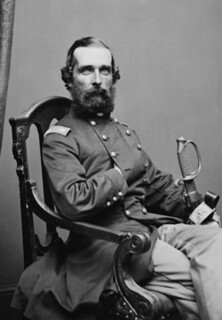 Mark Wilks Collet (1826-1863) was a physician practicing in Camden, New Jersey. He was married to
Rosalie Jane Donath and had three children.
Mark Wilks Collet (1826-1863) was a physician practicing in Camden, New Jersey. He was married to
Rosalie Jane Donath and had three children.
Collet was one of eight men to form The Numismatic Society of Philadelphia, holding their first meeting on January 1, 1858. It is credited as the first numismatic society in the United States. An earlier group in New York is also noted.
He joined members J. Ledyard Hodge and Alfred B Taylor as co-authors of Catalogue of American Store Cards, &c., With Space for Marking the Condition, Price, Rarity, &c. of Each Piece, Designed for the use and Convenience of Collectors, published in 1858. The book included more open space than text.
Attinelli (Numisgraphics) wrote, Though useful at that time, the above-named society would probably
find more honor than profit in issuing a revised copy. The above has, like an old city directory, become
useless.
Bowers wrote in American Numismatics Before the Civil War, Apparently, Hodge and his co-authors ventured into a territory beyond their collective expertise.
The book included on page 1 Scale of the Numismatic Society of Philadelphia
which was divided in
increments of 1/16 inch and used to describe the size of medals. This is more commonly known as The
American Scale. Although Collet is credited with developing the scale, it is never called the Collet Scale.
Any contributions from Hodge and Taylor are ignored.
Collet had prior experience serving in the army of czarist Russia and served as a colonel in the Union Army during the Civil War. He died during the battle of Chancellorsville (Salem Church). He is buried at Saint James the Less Episcopal Churchyard in Philadelphia. A son, also named Mark W. Collet, was born six months after his death.
Michael Robert Kolman, Jr. (1906-1970) was born in Glassport, Pennsylvania. He was married to Violet Mason and had a son and a daughter.
Kolman owned the Mason Coin Shop in Williamsburg, Pennsylvania, before opening Federal Brand
Enterprises, Inc, in Cleveland in 1942. In 1958 he opened a branch office in, The Arcade,
in Cleveland.
He conducted 41 mail bid sales between 1956 and 1964.
He joined the ANA in 1944 as member 10398. In 1954 he converted to life membership LM-79. He was also a member of the ANS.
Kolman was a specialist in error coins, one of the founding members of the Collectors of Mint Errors (C.O.M.E.) and founding president in 1956. He served as editor of the C. O. M. E. Bulletin.
Kolman and Dr. Jack Litman developed The Kolit Position Gauge which was announced in the December issue of the newsletter. It was used to describe the size for off center strikes and clipped planchets.
Directions were based on the hands of a clock. Thus a clip at 3 o'clock was in the K-3 direction. The system was also described in Hobbies Magazine.
He was the author of Numismatic Lincoln Cent Errors in 1960. This illustrated the Kolit Position Guide and brought it into public usage. In 1963 the book was enlarged and revised as Numismatic Flying Eagle, Indian and Lincoln Cent Errors.
The use of Kolit position numbers has been adopted beyond the field of error coins. An example might be a rim ding described as located at K-3.
Kolman died in a Pittsburgh nursing home with the funeral at the Byrne Memorial Home. This was run by Pittsburgh numismatist Ray Byrne. He is buried at Homewood Cemetery in Pittsburgh.
Jack Howard Litman (1916-1967) was born in Pittsburgh but lived most of his life in Akron. He graduated from the University of Akron and later the Ohio University Dental College. He was a captain and dentist in the Air Force during World War II.
He was married to Beverly with two sons and practiced as a dentist in Akron.
Litman joined the ANA in 1955 as member 24354. He was an award-winning numismatic exhibitor. He served as president of the Akron Coin Club, the Penn-Ohio Coin Club and Collector of Mint Errors (C.O.M.E). Also he was general chairman for Akron coin shows.
Litman did not write books or articles. It was Kolman who got all the attention and most of the credit for the Kolit Position Gauge.
Litman died in Akron General Hospital and is buried in Rose Hill Cemetery.
THE FIRST BOWERS AND RUDDY PUBLIC AUCTION
A Stack's Bowers article discusses the first Bowers and Ruddy public auction, which took place fifty years ago this past May. -Editor
In 1972, our predecessor firm Bowers and Ruddy presented their first public auction, which featured The Armand Champa Collection and other important properties. The catalog bore the company name as American Auction Association. This name would also be used on the next four auction catalogs produced by Dave Bowers and Jim Ruddy before they began to use Bowers and Ruddy Galleries
on the Austin Collection catalog in May 1974.
This first sale was held at the Holiday Inn in Hollywood California where the firm was located and contained over 1,200 lots. Mr. Champa would return to Dave Bowers more than two decades later to auction his incredible numismatic library in a series of four sales offered by Bowers and Merena Galleries in 1994 and 1995.
To view The Armand Champa Collection and other catalogs by Bowers and Ruddy Galleries, click here:
https://stacksbowers.com/auctions/catalog-library/
I never had the opportunity to meet Jim Ruddy, but I've been happy to know and spend time with both Dave Bowers and Armand Champa over the years. Both were avid bibliophiles and supporters of NBS. -Editor
To read the complete article, see:
DID YOU KNOW- 50 YEARS AGO BOWERS AND RUDDY PRESENTED THEIR FIRST PUBLIC AUCTION?
(https://stacksbowers.com/did-you-know-50-years-ago-bowers-and-ruddy-presented-their-first-public-auction/)
THE MONEY MUSEUM AT THE CLEVELAND FED
Back in June we discussed the museums at the St. Louis and Chicago Federal Reserve Branches. Michael Kodysz passed along an article about the museum at the Cleveland Fed, but his note was misplaced for a while - sorry! -Editor
Mike writes:
"I don't think most people know that there's a Money Museum in the heart of downtown Cleveland. And it's free!
"I visited several years ago and found it worthwhile, even though many of the displays are geared toward schoolchildren visiting for field trips. One interesting aspect of the museum is that some exhibits show how the money is protected.
Here's an excerpt from the article. The Museum reopened July 18th. -Editor
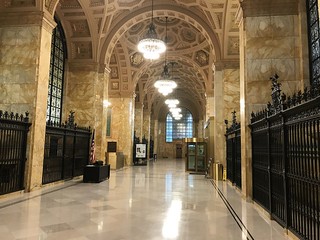 Money can't buy happiness, but at the Federal Reserve Bank of Cleveland it can educate you.
Money can't buy happiness, but at the Federal Reserve Bank of Cleveland it can educate you.
The interactive and informative all-ages Learning Center and Money Museum, which has been shut down since coronavirus pandemic restrictions took hold in 2020, is reopening its exhibits geared for all ages Monday, July 18. It's really a smart mashup of American history and accessible economics.
The museum, which attracts 10,000 to 12,000 visitors annually, is popular with families, summer campers and walk-in visitors – especially out-of-towners strolling around downtown.
It's a fun museum worth sauntering in to learn about all things currency. A video gives a glimpse into the bank's vault, which is closed to the public.
A timeline of the history of the federal reserve, a breakdown of what the codes mean on a bill, and other educational features are presented.
And, of course, the bank's famed money tree with assorted dollar bills dangling from its branches is a hit with kids, as is a giant dollar bill with George Washington's face cut out – a photo opportunity for visitors. It sits below typographical artwork depicting printed synonyms for money – shinplaster to sawbuck and more.
The updated 1923 building is a fortress: Part of the exhibits will show how the building is protected, originally with gun turrets and now bulletproof glass and other modern security measures. Equipment like gas masks and old-fashioned billy clubs also are shown.
Safest building in the city,
Finley said.
Bank officials maintain a good relationship with schools, he said. Two levels of educational classroom spaces have been renovated and are technologically up to date. New flooring, light fixtures, carpets, video screens and more have been installed.
Love the money tree! Mike also passed along an article with information about the building itself. -Editor
Mike adds:
"The article discussed the architecture, which is very elaborate, and includes several historical images. I like this quote: "All in all, the building—inside and outside—seems to say "Not only is your money safe but it's living better than you are.'"
To read the complete articles, see:
After hiatus, Federal Reserve Bank's Money Museum re-opens Monday, July 18 (photos)
(https://www.cleveland.com/entertainment/2022/07/after-hiatus-federal-reserve-banks-money-museum-re-opens-monday-july-18.html)
Federal Reserve Bank of Cleveland
(https://clevelandhistorical.org/items/show/310)
To read the earlier E-Sylum articles, see:
THE ECONOMY MUSEUM AT THE ST. LOUIS FED
(https://www.coinbooks.org/v25/esylum_v25n24a16.html)
THE MONEY MUSEUM AT THE CHICAGO FED
(https://www.coinbooks.org/v25/esylum_v25n24a17.html)
HERITAGE TOKEN AND MEDAL SELECTIONS
Here are some tokens and medals that caught my eye in the August 15, 2022 Heritage sale. -Editor
Lot 91098: 1861 Bombardment of Fort Sumter Medal
To read the complete lot description, see:
1861 Bombardment of Fort Sumter, Silver, So-Called Dollar, HK-11f, Unique, MS64 Prooflike NGC. An early, popular, and...
(https://coins.ha.com/itm/so-called-dollars/1861-bombardment-of-fort-sumter-silver-so-called-dollar-hk-11f-unique-ms64-prooflike-ngc-an-early-popular-and/a/60273-91098.s)
Lot 91443: 1858 Pioneer Baseball Club Token
To read the complete lot description, see:
1858 Pioneer Baseball Club, Springfield, MA, Rulau Mass-528, Musante JAB-1, MS61 NGC. Silver-plated white metal, plai...
(https://coins.ha.com/itm/u.s.-merchant-tokens-1845-1860-/1858-pioneer-baseball-club-springfield-ma-rulau-mass-528-musante-jab-1-ms61-ngc-silver-plated-white-metal-plai/a/60273-91443.s)
Lot 91489: New York Civil War Sutler Token
To read the complete lot description, see:
(1861-65) G.C.F. 5th New York Volunteers, Civil War Sutler Token, S&I-NY-5-50Z, R.9, MS62 NGC. Lead....
(https://coins.ha.com/itm/civil-war-tokens/-1861-65-gcf-5th-new-york-volunteers-civil-war-sutler-token-sandi-ny-5-50z-r9-ms62-ngc-lead/a/60273-91489.s)
Lot 91506: New Orleans International Industrial & Cotton Exposition
To read the complete lot description, see:
(1884-85) International Industrial & Cotton Exposition, New Orleans, LA, Rulau-LA-NO-57B, MS64 Brown NGC. Bronze....
(https://coins.ha.com/itm/u.s.-trade-tokens-1866-1889-/-1884-85-international-industrial-and-cotton-exposition-new-orleans-la-rulau-la-no-57b-ms64-brown-ngc-bronze/a/60273-91506.s)
Lot 91538: 1924 Manitoba Gold Indian Head
To read the complete lot description, see:
1924 Manitoba (Canada) 9 kt Gold Indian Head, Greene-798, MS64 PCGS....
(https://coins.ha.com/itm/western-souvenir-gold/1924-manitoba-canada-9-kt-gold-indian-head-greene-798-ms64-pcgs/a/60273-91538.s)
FEISEL AUGUST 2022 TOKEN SALE HIGHLIGHTS
Here's an announcement with some highlights from the upcoming token sale from Duane Feisel, closing on August 28, 2022. He can be reached at dhfeisel@frontier.com . -Editor
The color on-line version of the auction listing has been posted on the website of the National Token Collectors Association (NTCA) and can be viewed on-line if you are a NTCA member. The printed version of the listing in "Talkin' Tokens" (the monthly publication of NTCA should soon. be delivered by the USPS. If you are not yet a member of NTCA, please let me know and I'll provide you with membership information.
Lot 20 PALACE SALOON / E. STOCKER / PROP. / FOSTERIA, CAL. / (sm: L.A. RUB. STP. CO.) // Good For / 10 / (on label across: Cent) / Drink, br rd 23mm. Listed 2F-1 $750/1,500. G3-MB$750
Lot 134 DOLLY OGDEN / 326 MASON STREET // Toujours / Le / Meme / / (sm: L.H. Moise. S.F.), (San Francisco CA), br rd 29mm. G4-MB$500
Lot 137 EVA YOUNG / PROPRIETRESS / SHERIDAN, WYO. // Good For / 20¢ / In Trade, al rd 29mm. G4-MB$500
Lot 163 LEWIS & CLARK / CENTENNIAL / 19 (cent 1905) 05 / SOU-VENEER / PORTLAND, ORE. // Wood Keep / A Lucky Cent / (cent) / Fir Fortune / Don't Pine – Spruce Up – All's Oak'a, black imprint wood rd 38mm, crack. Most unusual! G5-MB$50
Lot 212 THE COMET / J.D. VIETTI / PROP. / CONGRESS, A.T. // Good For / One / Drink / (sm: C.A. Klinkner & Co. S.F.), br sc-12 26mm, center punchmark. Listed CON-135 R8 $600. G3-MB$500
Lot 528 WINTER BROS. / GEN'L. / MDSE. / CARLOCK, S.D. // Good For / 10 / Cts. / In Trade, br rd 24mm. Listed, rare locality! G3-MB$225
Color images of lots can be viewed on-line at:
https://collector-ca.smugmug.com/Tokens-Exonumia/2022-AUGUST-MAIL-BID-SALE/
ANCIENT JEWISH COINS IN ROBINSON 119TH AUCTION
Frank Robinson's next sale is coming up in September. Here's the press release. -Editor
Dealer Frank S. Robinson will conduct his 119th mail and internet auction of Ancient and Early Coins with a closing date of September 6. The sale will include 602 lots, low minimum bids, and bids to be reduced as competition permits. Robinson notes that reductions have averaged 15-20% in his recent sales. There is no buyer fee.
Featured in this sale is the first segment of a major collection of Judaean and Judaic related material, including some rare and important items. Highlights include a VF Yehud
coinage Gerah with large ear (of God?); a First Revolt Year One Shekel in VF; an AEF Bar Kokhba Zuz with grapes/trumpets; and a Choice VF+ Judea Capta denarius of Vespasian.
Greek coins include several very Choice classic Athenian owl
tetradrachms; a rare Elymais silver Tetradrachm of Kamnaskires V in Choice EF; a rare VF Kroton Didrachm with facing bust; and a Choice EF Shekel of Tyre.
Among Roman coins there is Choice EF Agrippa As; a Caligula Sestertius in F-VF; an AEF/VF Domitian Sestertius; and an EF Constantius I Argenteus.
This sale will also feature final offerings from Robinson's personal collections of early Spanish and English coins; and a selection of early Chinese coins, many in group lots; Byzantine and other early coinages, other group lots, literature, and a section of items offered at fixed prices.
Robinson holds about three auctions annually, and tries to offer a broad range of material for advanced collectors as well as bargain hunters. Catalogs are free; contact Robinson at Box 8600A, Albany, NY 12208; phone/fax 518-482-2639; e-mail frank@fsrcoin.com. The full catalog is at his website, www.fsrcoin.com.
You can usually count on Frank's catalogs to include some surprises... -Editor
COIN Restoration Machine, the device you've always dreamed of, combining the latest in AI, 3-D printing & quantum computing technology; just place a coin in the slot, press the button, and the coin comes out as new, minus any corrosion, nicks, wear, etc. Satisfaction guaranteed $199.95
THE BOOK BAZARRE
NUMISMATIC NUGGETS: AUGUST 14, 2022
Here's a selection of interesting or unusual items I came across in the marketplace this week. Tell us what you think of some of these. -Editor
Antonius Pius 138-161 Ausreus gold 6.9g rare condition very fine to extremely fine
From the Münzen & Raritätenshop Weekly Auction No. 118. -Editor
To read the complete lot description, see:
COME ON. NUMBER 1 Anthony Pius 138-161
(https://muenzenonline-auktion.ch/catalog-archiv-detail/detail/weekly-auktion-118-1658146076/antonius-pius-138161-69121)
SCOTLAND. Ayrshire. 1/2 Penny Token, 1797. NGC MS-65 Red Brown.
D&H-3. Obverse features armored bust left of William Fullarton (1754-1808) MP, later Governor of Trinidad in 1802, "GULIELMUS VALLAS" around; Reverse: female seated, left arm resting upon a shield, "SCOTIA REDIVIVA" around, 17 TC 97 in exergue. Edge: Plain. Comes with dealer tag.
From the Stack's Bowers Summer 2022 Global Showcase Auction. -Editor
To read the complete lot description, see:
SCOTLAND. Ayrshire. 1/2 Penny Token, 1797. NGC MS-65 Red Brown.
(https://auctions.stacksbowers.com/lots/view/3-XVZ6M/scotland-ayrshire-12-penny-token-1797-ngc-ms-65-red-brown)
Also from the Stack's Bowers Summer 2022 Global Showcase Auction. What does the "MEX" mean? -Editor
To read the complete lot description, see:
DANISH WEST INDIES. 3 Cents Token, 1890. PCGS AU-55.
(https://auctions.stacksbowers.com/lots/view/3-XVDGJ/danish-west-indies-3-cents-token-1890-pcgs-au-55)
Meiji gold Pattern 10 Yen Year 3 (1870) MS66 NGC, Osaka mint, KM-Pn19, J&V-Ma1, JNDA-pg. 83, JC-Unl. Arguably one of the finest representatives within the entire Japanese series, indescribable in just a few words, which remains the epitome of both conditional and absolute rarity. Pattern coins produced during the Meiji era remain a notoriously difficult section of the Japanese numismatic market, with so few ever reaching the market, especially in as advanced a preservation as seen here.
For hundreds of years prior to the Meiji era, during a tumultuous time of shogunate rule, commerce had been conducted using various cast and hammered coinage, with cash pieces the inspiration of circulating Chinese issues of the day. Similar to their western counterparts, minting in this fashion had numerous drawbacks as economies grew and evolved, including inconsistency of quality and volume of production to keep up with increasing demand. The 19th century brought about substantial foreign influence in Japanese politics, leading to the Meiji Restoration in 1868. This period of "Enlightened Rule" marked the beginning of industrialization for the nation, radically changing economic conditions and accommodated by the establishment of a gold standard based on the Yen. This required the modernization of minting capabilities, and thus a central minting facility in Osaka was established. Presses purchased from the British colonial Hong Kong mint, which shuttered after just two years from both poor economic performance and negative local reception of its coinage, would produce a series of Patterns and circulation issues shortly thereafter, including the present example.
From the Heritage 2022 August 25-28 Platinum Auction. -Editor
To read the complete lot description, see:
Japan: Meiji gold Pattern 10 Yen Year 3 (1870) MS66 NGC,...
(https://coins.ha.com/itm/japan/japan-meiji-gold-pattern-10-yen-year-3-1870-ms66-ngc-/a/3101-34307.s)
1927-D $20 MS66 PCGS. Ex: Dallas Bank-Simpson. In their classic reference, Encyclopedia of U.S. Gold Coins 1795-1933, Jeff Garrett and Ron Guth call the 1927-D Saint-Gaudens double eagle "a legendary rarity-the rarest regular-issue gold coin of any denomination of the 20th century." Of course, the 1933 double eagle was once even more elusive, before a group of 10 specimens was discovered in 2005. Unfortunately, the U.S. government contends the 1933 was not "regularly issued" and only one of the known specimens is legal to own, making the issue essentially uncollectible. For all intents and purposes, the 1927-D is "truly the king of all 20th century gold coins", as Garrett and Guth contend. Heritage Auctions is proud to present a spectacular Premium Gem example of this celebrated gold rarity in just its third auction appearance.
From the Heritage August 22-28, 2022 Signature Auction. At publication time the bidding was up to $1.75 million. -Editor
To read the complete lot description, see:
1927-D $20 MS66 PCGS....
(https://coins.ha.com/itm/saint-gaudens-double-eagles/double-eagles/1927-d-20-ms66-pcgs-pcgs-9187-/a/1348-3417.s)
A BRONZE FOLLIS OF ANASTASIUS
In an email to clients earlier today, dealer Allan Davisson examined a particularly fascinating lot in the upcoming Davisson's sale. -Editor
The Roman Senate issued this bronze follis long after the Rome that ruled so much of the known world had disappeared, sometime in the AD 512-522 period, during the reign of Anastasius in the East. The coin with its image of Roma on the obverse and the she-wolf suckling the twins Romulus and Remus was a distinctive use of symbols that were reminiscent of coins of the long-gone Roman Republic.
Theoderic (454-526), an Ostrogoth, had been a hostage in Constantinople when he was young. He had a Roman upbringing there and his appreciation for Roman culture was such that a modern historian, Peter Brown, states that Theoderic was in the habit of commenting that ‘An able Goth wants to be like a Roman; only a poor Roman would want to be like a Goth.'
He was a fierce leader but he also is credited with restoration of buildings and public structures in both Ravenna and Rome. Heather's volume comments about an astonishing manuscript,
a luxury copy of a translation of the four Gospels into the Gothic language,
a colossally expensive book commissioned by quite likely Theoderic…in the sixth century.
His life was a series of battles about ruling Italy. In 471, after the death of his father, he became leader of the Ostrogoths (471-526). In 489, Zeno, the Eastern emperor (474-491) had Theoderic march into Italy to defeat the ruler Odoacer whose claim to kingship of Italy was based on his overthrow of Romulus Augustus. The comprehensive Wikipedia entry on Theoderic notes that he controlled an empire stretching from the Atlantic Ocean to the Adriatic Sea
and adds that some of his subjects referred to him by the title augustus. He was tolerant of Roman customs and governance. He had a relationship with Anastasius, Zeno's successor, that resulted in the issuance of this coin by a temporarily revived Roman senate.
A personal note: This coin came in a consignment and was unfamiliar to all three of us. In following up on the piece, I found myself spending an afternoon revisiting an era that I read about many years ago when I first ran into works by Peter Heather, an historian of this era. This period in history can be fascinating but it can also be confusing with the unfamiliar names and the shifting alliances, borders and battles.
Heather comments that In 453 after a decade of mayhem stretching from Constantinople to Paris, Attila the Hun died from the after-effects of one-too-many wedding nights.
The frenzied race for power
began not only with his sons but across his empire. Theodoric the Amal (family name) was one of the successful leaders who emerged later in the century. But this period of turmoil was not always clearly chronicled. Nor are many of the names and events familiar to most modern casual readers.
During the hours I spent trying to pin the story down I found some consistency but also some variation of opinion. Wikipedia—a reference I discouraged in bibliographies when I was teaching—has what seems a particularly well researched account of Theodoric. David Sear's authentication certificate has a lengthy discussion of the background of this coin as well. And two volumes by Heather (Empires and Barbarians, The Fall of Rome and the Birth of Europe 2009. Oxford Univ. Press, and The Fall of the Roman Empire, A New History of Rome and the Barbarians 2006, also Oxford…) are particularly helpful as they place this period in a larger context.
To read the complete lot description, see:
E-Auction 44 Lot 101
(https://davcoin.com/lot/e-auction-44-lot-101)
For more information on the sale, see:
https://davcoin.com/
ANCIENT COIN IMPORT RESTRICTIONS
A recent CoinWeek article by Tyler Rossi discusses import restrictions affecting collectors of ancient coins. Here's an excerpt - see the complete article online. -Editor
Ask a collector of ancient coins if they have ever bought a coin from an overseas vendor, and you will more likely than not receive a positive response.
And while many collectors will have never experienced a problem with Customs, everyone will have heard at least a few horror stories of coins being delayed or even seized. While these collectors are not smugglers–and the vendors have almost definitely filled out the paperwork as accurately as possible–they have still fallen victim to an overly complex and ill-defined system of enforcement that represents what has been called by my CoinWeek colleague Mike Markowitz a global war against collectors
of ancient coins.
It would be futile to argue that ancient coins are never subject to archaeological looting. In fact, a grouping of 91 gold Roman Imperial coins and 3,000 other coins, valued at over half a million dollars US, were recently seized in a massive operation called Pandora VI. Initiated by the Spanish Guardia Civil and organized by Europol, INTERPOL, and the World Customs Organization, it engaged 28 different countries. This operation made national news in March of this year. But while definitely a major case, Pandora VI is actually rather unusual, since most items of cultural importance seized by Customs are in fact smuggled coins. Usually, coins make up only a fraction of looted and smuggled goods.
Despite this, many Western countries have begun to ban the importation of ancient coins.
In the United States, this drive began back in 1983 when the national government first passed the Convention on Cultural Property Implementation Act (CPIA). This law was created as a vehicle to implement the 1970 UNESCO Convention on the Means of Prohibiting and Preventing the Illicit Import, Export and Transfer of Ownership of Cultural Property. By creating this framework, UNESCO was hoping to enable cooperation between governments in the fight to protect cultural heritage and limit the looting or smuggling of archaeological items.
Shortly thereafter, the CPIA was used to establish the Cultural Property Advisory Committee (CPAC). This panel of presidential appointees has 11 members sorted into several categories: two represent museums; three represent the fields of archaeology, anthropology, and ethnology; three are experts in the international sale of cultural property; and the last three represent the general public. Unfortunately, this panel is not finely attuned to the details surrounding ancient numismatics.
To read the complete article, see:
Collecting Ancient Coins in an Era of Import Restrictions
(https://coinweek.com/education/collecting-ancient-coins-in-an-era-of-import-restrictions/)
THE "UPRIGHT 5" GOLD DOLLARS
A recent CoinWeek article describes Craig Krueger's interesting research on the "Upright 5" Gold Dollars and traces the evolution of the slanted 5 on U.S. coin types from 1850 to 1855. Here's an excerpt - see the complete article online. -Editor
In 1856, the United States Mint struck gold dollars with two distinctly different date logotypes. The Slanted 5
variety, which is the much more frequently encountered version, features an italicized 5. This had been the style employed by the Mint through the first six years of the 1850s. The other style, Upright 5
, cut a more up-and-down figure.
In June 2002, Krueger and noted expert John W. Dannreuther produced an article for The Numismatist titled A New Slant on Coins of 1850-56
, in which the two posited their belief that the appearance of the upright date logotype towards the end of 1856 was the result of an effort to standardize the dates on all U.S. coins. They also put forward evidence that the Upright 5
was produced after the Slanted 5
variety – a position that is supported by the complete shift away from italicized numerals on all U.S. denominations starting in 1857. The quality of research undertaken to produce the article earned the pair the ANA's prestigious Wayte and Olga Raymond Memorial Literary Award.
Krueger's deepening understanding of the variety also led him to write a follow up piece about the variety, which was published in the The Numismatist in 2005. In the piece Making the Grade: The 1856
, Krueger approximated the relative scarcity for the variety, citing opinions from leading numismatists and his own observations. According to Krueger's research, the Mint likely struck no more than 75,000 examples of the Upright 5. A paltry sum compared to the 1,687,936 coins that were likely struck using dies with the italicized date.
Upright 5
Gold Dollar
A limited number of coins will be on display in Chicago at the 2022 World's Fair of Money at dealer Julian Leidman's booth. Some of the finer pieces will likely head to auction.
To read the complete article, see:
Deadwood Collection
of Upright 5 Gold Dollars Comes to Market
(https://coinweek.com/us-coins/large-hoard-of-upright-5-gold-dollars-the-deadwood-collection-comes-to-market/)
HARRIET TUBMAN COMMEMORATIVE COIN ACT
This article on the Harriet Tubman commemorative coins comes from a local newspaper in the area of the Tubman home in upstate New York. -Editor
Harriet Tubman Home, Inc., has two years to prepare for what could be a sizable windfall.
The passage of the Harriet Tubman Bicentennial Commemorative Coin Act would be reason enough for the Auburn landmark's leaders to celebrate. The legislation gives them one more: Half of the surcharges paid for the coins will be given to the Harriet Tubman Home.
When the Tubman coins go on sale in 2024, up to 50,000 $5 gold coins, 400,000 $1 silver coins and 750,000 half-dollar coins will be available. The surcharges would be $35 for the $5 coins, $10 for the $1 coins and $5 for the half-dollars. If all the coins are sold, the total surcharges paid will be $9.5 million. The Harriet Tubman Home would receive $4.75 million.
It would be a welcome influx of cash for the organization, which owns and operates the South Street property that's now part of the Harriet Tubman National Historical Park in Auburn. While there are park rangers on site, the Tubman Home maintains a presence. When park rangers aren't giving tours, Tubman Home staffers lead the tours.
When asked what they could do with the money, Karen Hill, who is the president and CEO of the Harriet Tubman Home, responded, What couldn't we do with it?
We have needs everywhere,
she said.
If the initial version of the bill had passed, the Harriet Tubman Home would not have benefited from the sale of the coins.
In 2020, the measure was first introduced with the goal of releasing the coins in 2022 — Tubman's 200th birthday. However, the organization that would've received the surcharges was Brooklyn-based Project Legacy.
Hill credited U.S. Rep. John Katko, who co-authored the Tubman coin bill, for securing the change and ensuring that the Tubman Home would benefit from the sale.
He was the real driver in terms of putting the Harriet Tubman Home into the legislation,
she said.
Katko, who spoke on the House floor before the final passage of the bill on Tuesday, called the vote one of the most significant steps forward in strengthening federal recognition of the Harriet Tubman Home since its designation as a national park in 2017.
Specifically, I am pleased that the coins issued under this legislation, bearing (Tubman's) likeness and symbolizing her legacy, will directly benefit preservation and education efforts at the Tubman Home in Auburn,
he said.
The bill now heads to President Joe Biden's desk for his review. He is expected to sign the legislation.
The Act was signed by President Biden. I'll look forward to seeing the design ideas. -Editor
To read the complete article, see:
Upstate New York historic site could benefit from Harriet Tubman coins
(https://romesentinel.com/stories/upstate-new-york-historic-site-could-benefit-from-harriet-tubman-coins,138976)
To read the additional articles, see:
House passes Harriet Tubman coin bill benefiting Auburn historic site
(https://www.syracuse.com/politics/2022/07/house-passes-harriet-tubman-coin-bill-benefiting-auburn-historic-site.html)
Biden signs bill for 2024 Tubman commemorative coins
(https://www.coinworld.com/news/us-coins/biden-signs-bill-for-2024-tubman-commemorative-coins)
MPC SERIES 641 50 CENTS PROGRESSIVE PROOF SET
The MPC Gram is an email newsletter for collectors of Military Payment Certificates and other military numismatica. An article by Larry Smulczenski in the MPCGram Series 23 No. 2535 13 Aug 2022 issue illustrates an interesting progressive proof set showing how the different colors come together to create the complete note. It's republished here with permission. -Editor
A Progressive Proof Set of the Series 641 50 cents
by Larry Smulczenski
It has always been a thrill for me to see a progressive proof set of any note and observe how the various individual colors and engraved lines meld together to form a beautiful banknote. The Comprehensive Catalog of Military Payment Certificates by Fred Schwan says that there were only two complete Progressive Proof Sets of Series 641 known in private collections. One set of the seven denominations remains in a collection while the other set has been broken up and individual denominations reside in the homes of several lucky collectors.
The 50c of the series is shown in black and white on page 69 on the MPC Catalog but we would like to show it to you here in living color. The face of the note is comprised of four colors. The first two colors, a light green and light blue may be a little hard to see but the dark brown is clear, and the vivid orange is exciting. The fifth image is a composite while the sixth has the plate position and serial number which are 48 and J00000000J respectively with the serial number indicating a specimen.
To subscribe to MPCGram, click here . -Editor
BANKNOTE RECONNECTS HOLOCAUST SURVIVOR
An old signed banknote helped identify the liberator of a Holocaust survivor. Can any of our sharp-eyed numismatists identify the note? -Editor
In 1945, Lily Ebert, now 90, was liberated from a German munitions factory where she worked as slave labor after being transferred from the Auschwitz death camp.
A few weeks after being liberated, an American soldier shared some words of positivity with her, "The start to a new life. Good luck and happiness," he wrote on a German banknote.
The simple gesture was life-changing for Ebert and the banknote became one of her most treasured keepsakes.
"This soldier was the first human being who was kind to us," she told NBC News. "It was the first time after this terrible life that somebody was kind and I knew that somebody wants to help."
Ebert's mother, brother, and sister were all killed at Auschwitz. Her two younger sisters were liberated with her at the munitions factory. She believes that she survived the ordeal due to her responsibility to take care of her sisters.
"I promised myself that if I survived by some miracle, I would tell the world what happened there," Ebert said. "The next generation and next generations should know the story so that something like that should not be repeated to any human being ever."
Ebert kept the banknote in a photo album at her home in London where it was discovered by her great-grandson, 16-year-old Dov Forman. Forman had taken it upon himself to start documenting his great-grandmother's stories as a survivor so they would never be forgotten.
Intrigued by the transcription on the banknote, Foreman tweeted out a photo of the bill along with photographs of the unknown soldier and Ebert taken a few days after liberation.
The only clue to the man's identity was an inscription on the banknote that reads: "Assistant to Chaplain Schacter."
The "Chaplain Schacter" eluded to on the bill was Chaplain Herschel Schacter, an American Orthodox rabbi who served as a chaplain in the Third Army's VIII Corps. Schacter participated in the liberation of the Buchenwald concentration camp and helped relocate survivors, including Nobel laureate Elie Wiesel.
The tweet went viral and Forman received responses from all over the world. Eventually, he learned the identity of the solider, Private Hyman Shulman from New Jersey.
Unfortunately, Shulman died seven years ago at the age of 91.
However, Forman was able to locate and contact Schulman's children in New York and bring the families together digitally through Zoom. "It was really special. It felt like we were family, we just clicked," Forman said.
To read the complete article, see:
Holocaust survivor uses banknote clue to find the family of 'kind' soldier who liberated her
(https://www.upworthy.com/holocaust-survivor-finds-family-of-the-soldier-who-liberated-her-using-a-clue-on-old-banknote)
THE BOOK BAZARRE
R.S. Yeoman and His Remarkable Red Book,also tells the history of Whitman Publishing as well as his own unique life story in and out of numismatics. Enjoy more than 100 years of fascinating numismatic history in 352 richly illustrated pages, 8.5 x 11 inches, hardcover. Order your copy online at Whitman.com , or call 1-800-546-2995.
DUMPSTER BANKNOTE STIRS VISION OF RICHES
Dick Hanscom passed along this story of a dumpster find that turned out to be ... well, read on to find out. -Editor
You wouldn't expect your life to change from dumpster diving, but for one Alaskan, that's exactly what she thought happened.
Just a few weeks ago, Ella Guest found herself restless in the middle of the night. To clear her head she decided to go for a walk with a friend. That friend suggested they dumpster dive — something Guest had never thought to do before.
Initially, it was some antique desks and posters that caught her eye. Digging deeper, she started throwing things around before she realized a paper note and what appeared to be foreign coins fell out of a stack of documents.
The first thing that I thought of when I found this was, I was like, ‘oh, it's probably like five bucks,'
Guest said.
After doing some of her own investigating online, Guest would later be shocked when she discovered that the notes appeared to be worth so much more.
What Guest found was 5 million Turkish lira. But what Guest first thought was a jackpot soon went bust. It turns out Turkish currency underwent new modifications several years ago and all the old currency is no longer in circulation. According to currency expert Tom Brosnahan, until the end of 2016, that old 5 million lira note could have been exchanged for 5 new liras, but that deadline has passed. It now has only souvenir value and a whole lot of disappointment for Guest.
Also consider: would a country ever issue so large a bill that had huge value? The largest US note is now $100; in Europe it was EUR500, but those are deprecated and the largest will soon be EUR100. There's a reason the 5 million lira note was in the dumpster,
Brosnahan said.
To read the complete article, see:
Anchorage woman thought she had a multimillion-dollar dumpster-dive find; hopes dashed
(https://www.msn.com/en-us/news/crime/anchorage-woman-thought-she-had-a-multimillion-dollar-dumpster-dive-find-hopes-dashed/ar-AA10rFHq)
LOOSE CHANGE: AUGUST 14, 2022
Here are some additional items in the media this week that may be of interest. -Editor
The American Numismatic Society published an episode of their podcast The Planchet which focuses on taking photos of coins with a Smartphone. -Editor
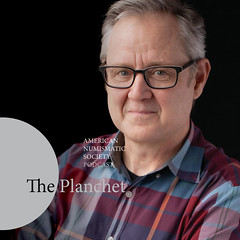 ANS photographer Alan Roche has been making coin images for the American Numismatic Society for 20 years. He brings his collected wisdom, creativity, and humor to The Planchet to offer listeners tips and tricks for creating great pictures with mobile devices of any numismatic material.
ANS photographer Alan Roche has been making coin images for the American Numismatic Society for 20 years. He brings his collected wisdom, creativity, and humor to The Planchet to offer listeners tips and tricks for creating great pictures with mobile devices of any numismatic material.
Total Time: 32 minutes
The Planchet is available wherever you get your podcasts or listen below:
To listen the complete podcast, see:
S3, Ep. 4. Tips for Photographing Coins with a Smartphone (with ANS Photographer Alan Roche)
(https://numismatics.org/pocketchange/03-04/)
Meanwhile, at the Massachusetts Historical Society, Library Assistant Evan McDonagh published a blog about about Lafayette medals. -Editor
Patriotic artisans found a popular subject in the Revolutionary War hero Gilbert du Motier, Marquis de Lafayette. Born on 6 September 1757 in Chavaniac, France as the orphaned son of a French aristocratic family, Lafayette traveled to the rebelling American colonies in July 1777 to obtain glory as a revolutionary fighter. Despite his lack of experience, the young soldier quickly won the friendship of George Washington. Lafayette earned distinction and fame for his actions at the Battle of the Brandywine in 1777, Barren Hill in 1778, and his successful campaigns against British commanders Benedict Arnold and Lord Charles Cornwallis in 1781.
By the war's end, Lafayette had attained nationwide fame, so much so that several states named him an honorary citizen during a 1784 visit. Lafayette's youth and reputation marked him as an ideal figurehead and symbol for Revolutionary War medals and tokens.
To read the complete article, see:
Highlight from the Collections: The Lafayette Medals
(https://www.masshist.org/beehiveblog/2022/08/highlight-from-the-collections-the-lafayette-medals/)
Last month Zimbabwe issued gold coins costing about US$1,800. Having sold over 4,000 of them, they're declaring the program a success. -Editor
Gold coins used as currency in Zimbabwe will soon be available in smaller denominations, the central bank says.
The average yearly salary in Zimbabwe for a civil servant is US$2,600, and according to the state-affiliated Herald newspaper 4,475 gold coins have been sold since their introduction last month.
This makes it a success in the eyes of the central bank.
To read the complete article, see:
Zimbabwe hails gold coin success and wants to issue more
(https://www.bbc.com/news/world-africa-62520693)
VIDEO: SCULPTURES MADE OUT OF COINS
This week I'll leave you with a YouTube video of sculptures made out of coins by a Finnish artist. The narrator pronounces "numismatist" as "num-is-MAT-ist", but whatever. Cool sculptures. -Editor
To watch the complete video, see:
VIDEO: See Incredible Sculptures Made Out of Coins by a Finnish Artist
(https://www.youtube.com/watch?v=Vz5ypRhmrPY&t=5s)

